The new
Busch and Muller Luxos dynamo headlights are setting a new standard for high-powered LED lighting, both in brightness and distribution of light. The Luxos U takes it one step further with a remote switch and USB charger.
All of the Luxos lights are able to be paired with a dyno powered tail light. The catch is that the tail light cannot be grounded to the frame or fender through the mounting screw. The will cause a fault circuit that detects a problem in the tail light. There will be problems with the functionality of the light and possible damage to the circuitry. This is a is a challenge because most of the popular fender mounted tail lights currently available offer the option of grounding through a wire or the mounting screw. My current favorite for both function and looks has been the
B&M Seculite plus.
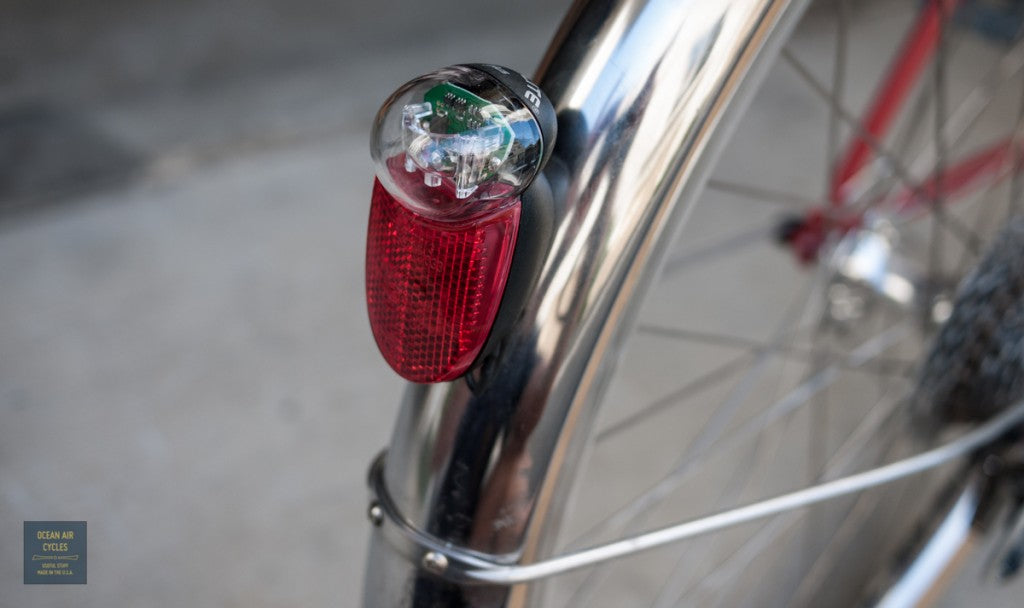
I had already gotten my sample Luxos wired up and going when I became aware of the issue with a grounded tail light. At first I was a little bummed, then the challenge was set, and I decided to figure out how hard this was going to be to fix. It turned out to be fairly simple, and I have outlined the steps here for you.
You will need a few basic tools: small flat head skew driver and small wire cutters will get you there, cir-clip pliers and a small Phillips head screw driver help make things a little easier.
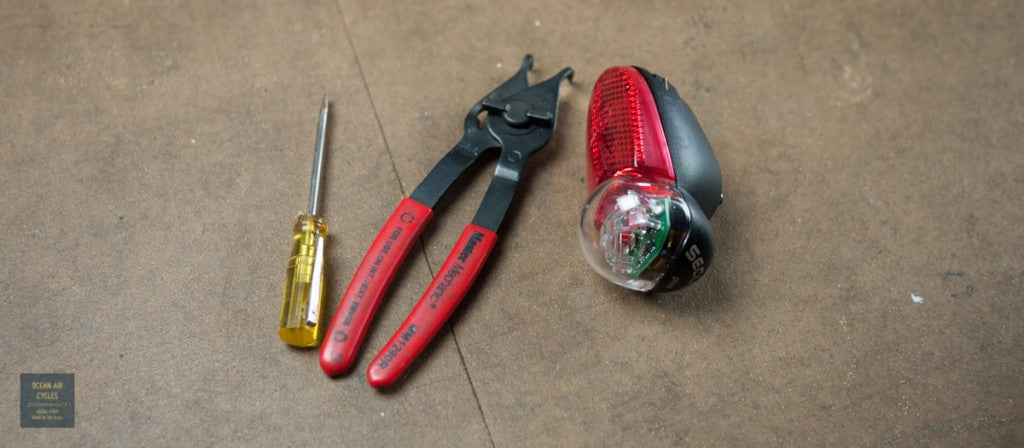
The first thing I did was remove the nuts and washer from the mounting screw. The first is the standard hex mounting nut. Then there is the round washer style nut that holds the bolt to the light body
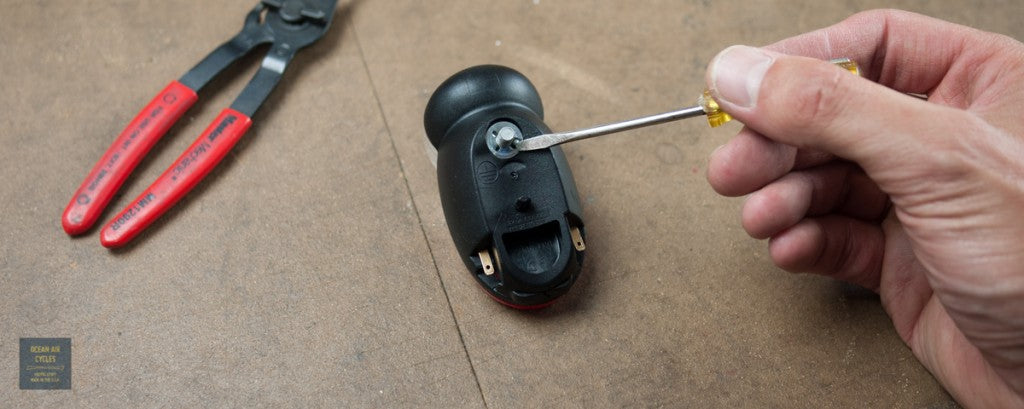
You can get this one off by carefully pushing it around counter-clockwise with the tip of your flat head screwdriver, but the cir-clip pliers made it a little easier.
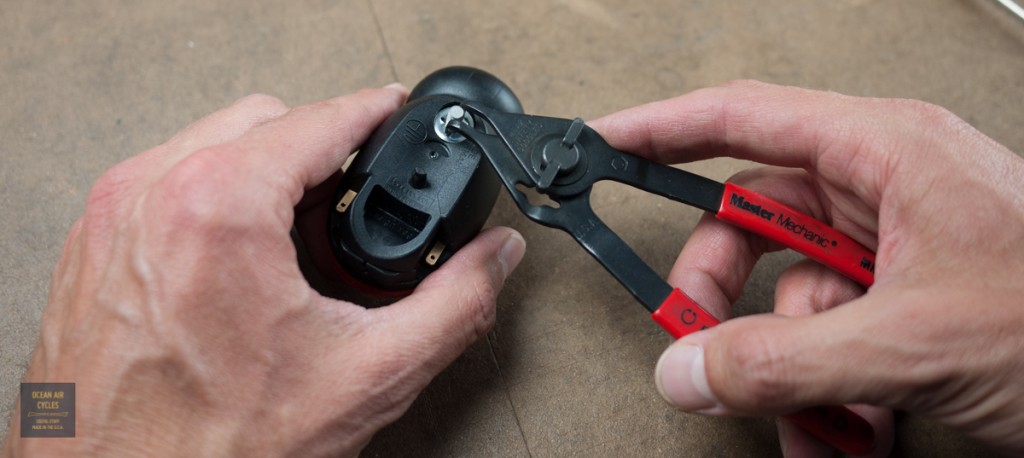
Once done you will be opening the light housing. Carefully work your way around the edges, starting from the bottom. The two halves of the housing are a press/snap fit together and can come apart safely as long as you are careful. I inserted the tip of the screwdriver into the thin gap between housings and lightly twisted to get it going.
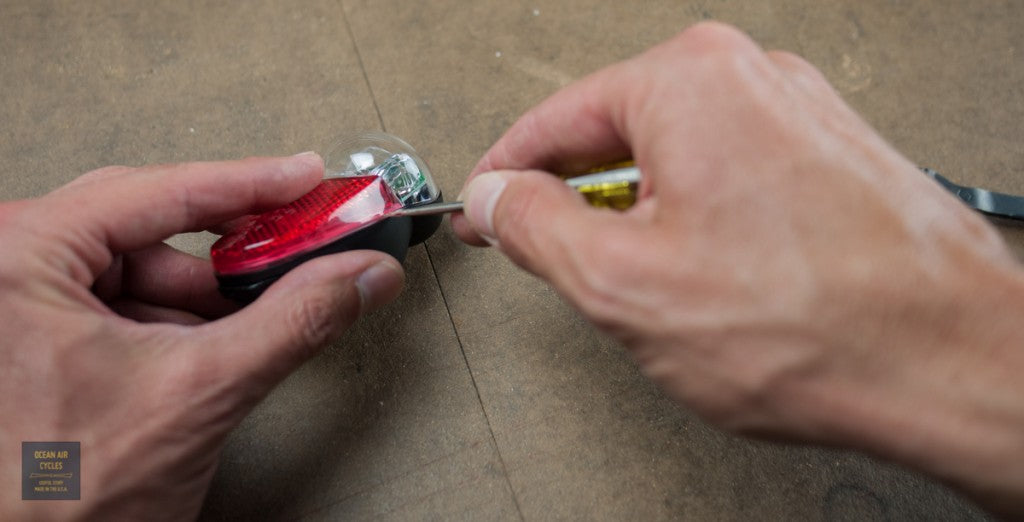
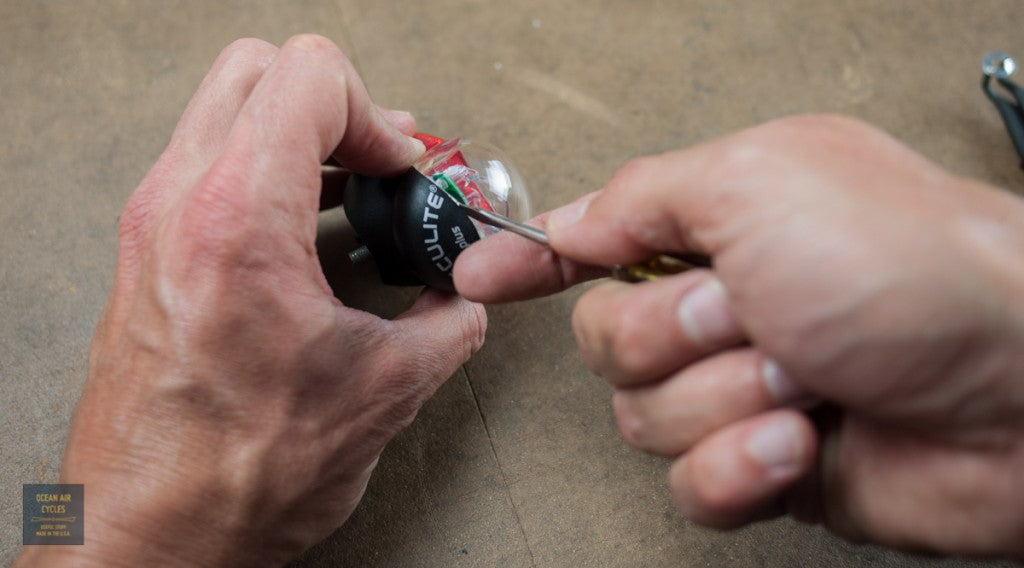
As you approach the top you need to be extra careful. This is where there is a small tab that indexes the two halves together. At this point I stopped using the tool and gently separated the two halves with my hands
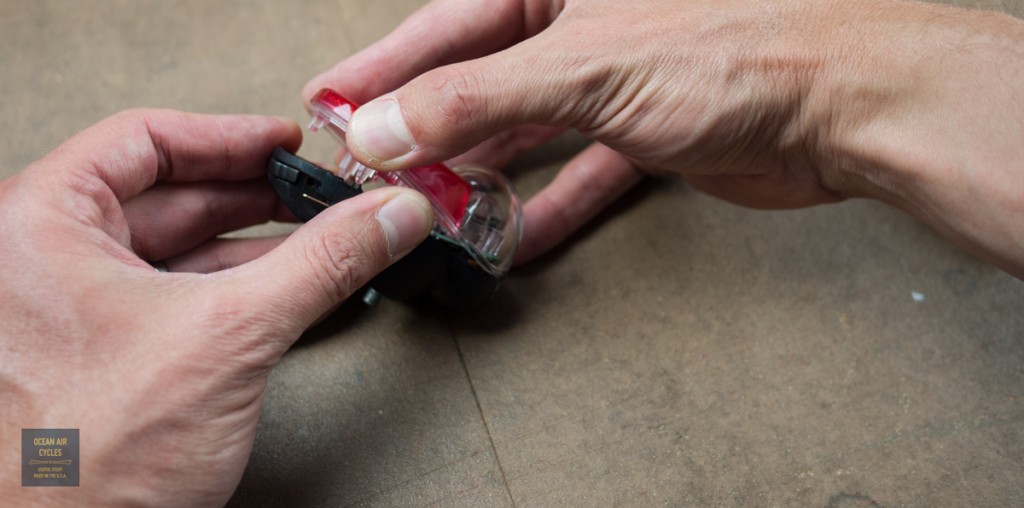
Once opened, you can easily see the above mentioned plastic tab.
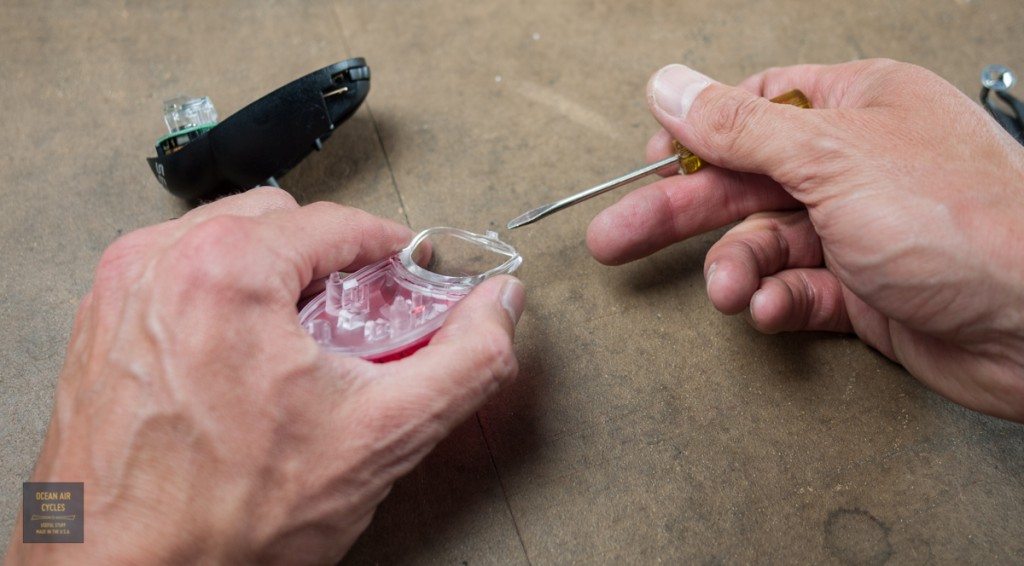
Moving on to the grounding of the light. The Seculite plus has two possible grounding paths. For most common installations involving a B&M headlight you will be wiring the tail light tot he front with a paired or co-axial conductor. The other grounding path is through the mounting screw. This is only used in cases where the frame of the bike and associated hardware are used as the grounding path. looking at the circuit board you can see both of the internal grounding wire options on the left side. The single wire on the left is for the positive lead.

The grounding wire to the frame mount needs to come out. It is connected to the mounting bolt with a ring connector. I was able to get the bolt out of the housing with the LED circuit board in place. If this is too tight for your comfort, you can remove the two Phillips head screws securing the board to the housing and you will then have plenty of room to work.
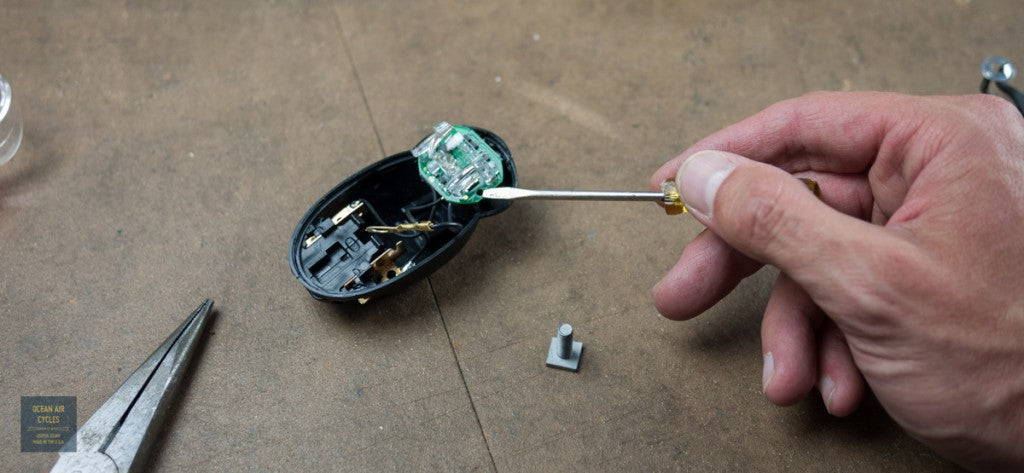
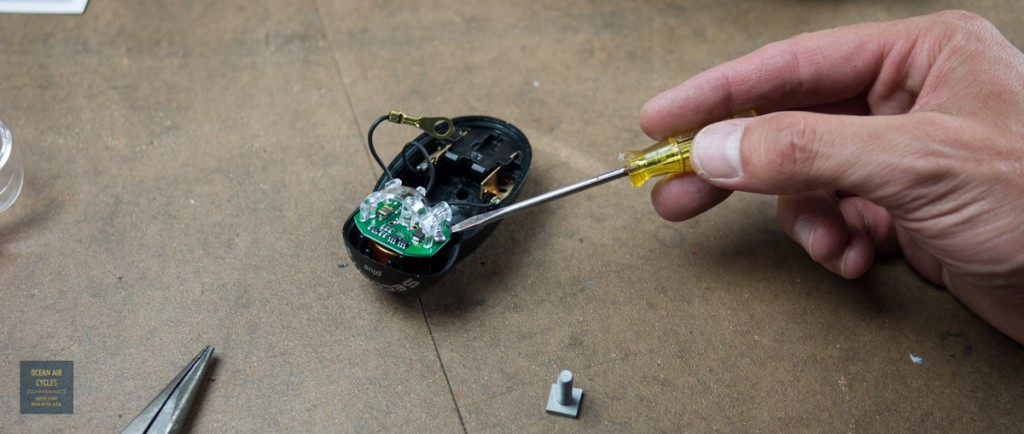
With the board out, you will want to snip the wire with the ring connector as close as you can to the board.
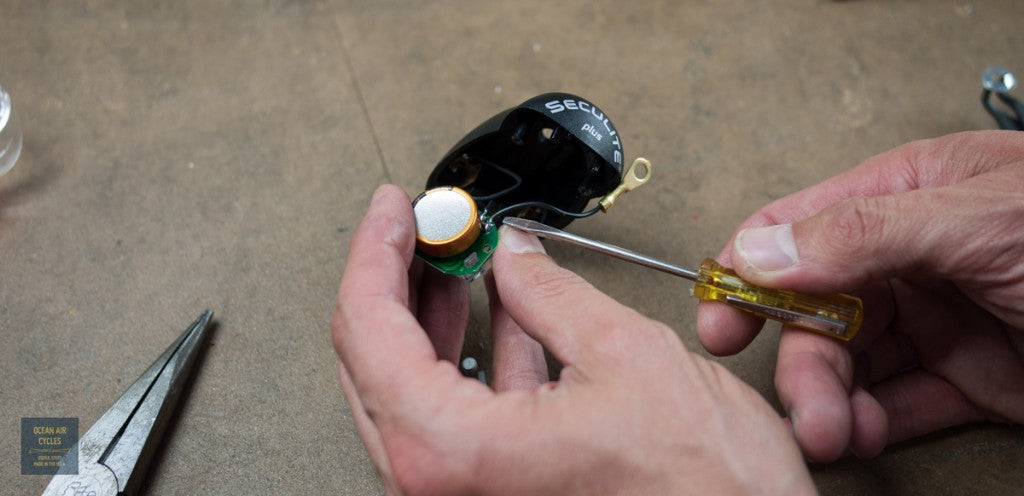
In theory you could leave the connector inside and isolate it, wrap it in electrical tape or shrink wrap, so that the process could be reversed. For this light I am pretty certain that it will never be wired with a frame ground path, so I snipped. While I had things appart I wired the Seculite into the Luxos U and confirmed that everything was as hoped.
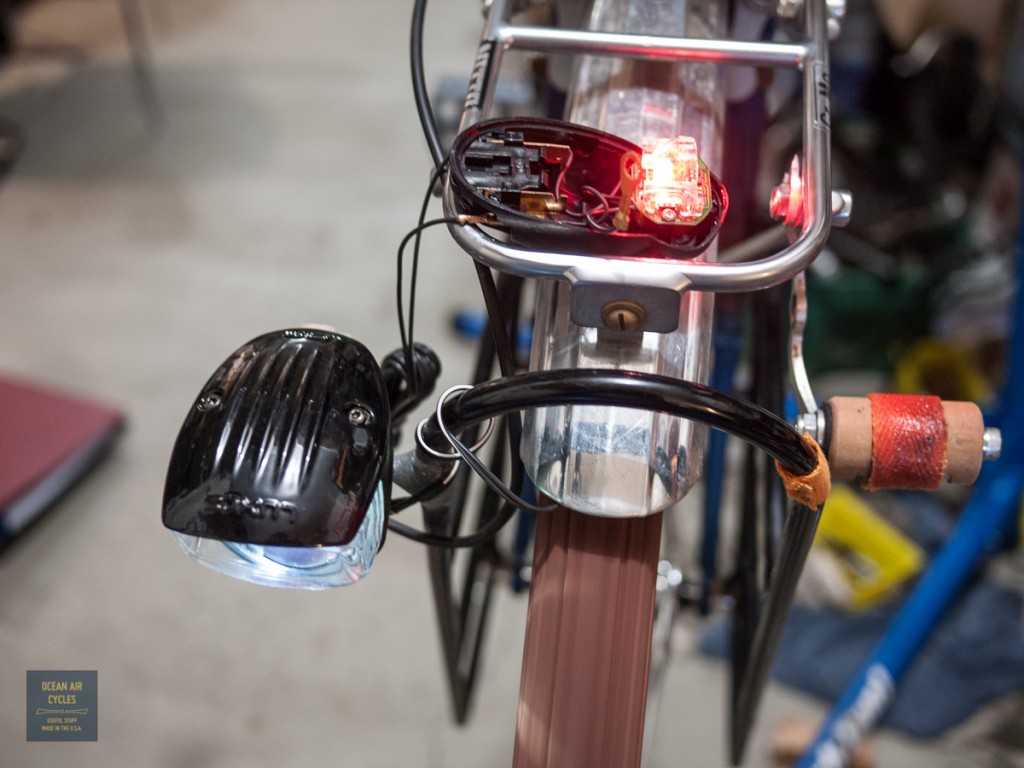
The re-assembly is a pretty straight forward reversal of the above steps. Double check that the remaining wire connection points are fully seated in the housing.
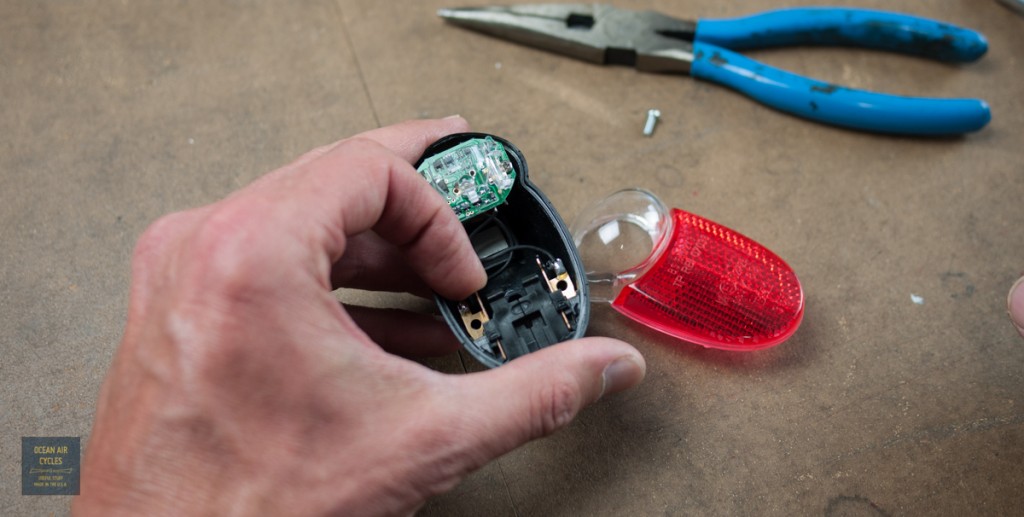
Insert the mounting bolt and fasten in place with the thin nut.

Carefully align the two housing halves and squeeze together, they should snap into place and the light is ready for wiring and mounting to the bicycle as usual
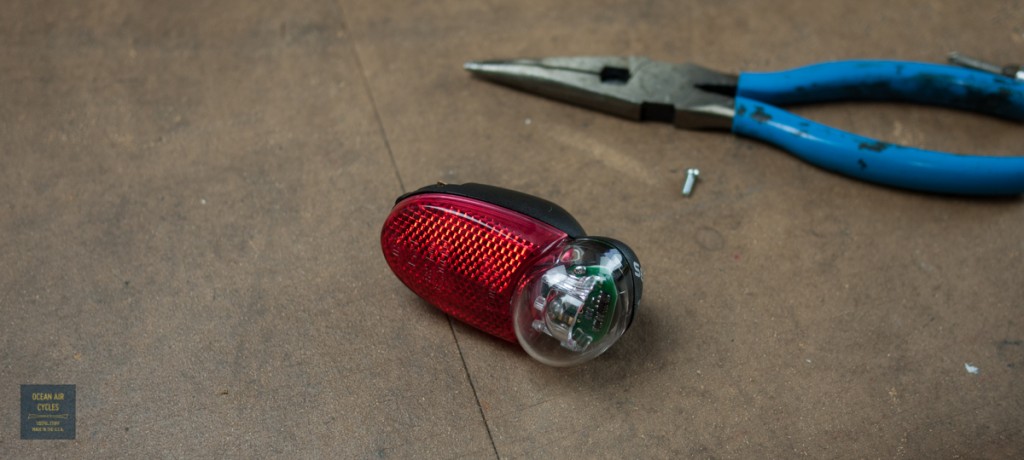
For the home mechanic that is comfortable with electrical work this is not too bad of a project to take on. If you feel that this is above your skill level, and want a Luxos Seculite combo from us, I am more than happy to perform this procedure for free.
Harbor Trip June 14 2013, 0 Comments

I met up with my buddy Aaron, on his Rambler, for a trip down to the Channel Islands Harbor this morning. It was a sort of rain check ride for the one that never happened on Wednesday.
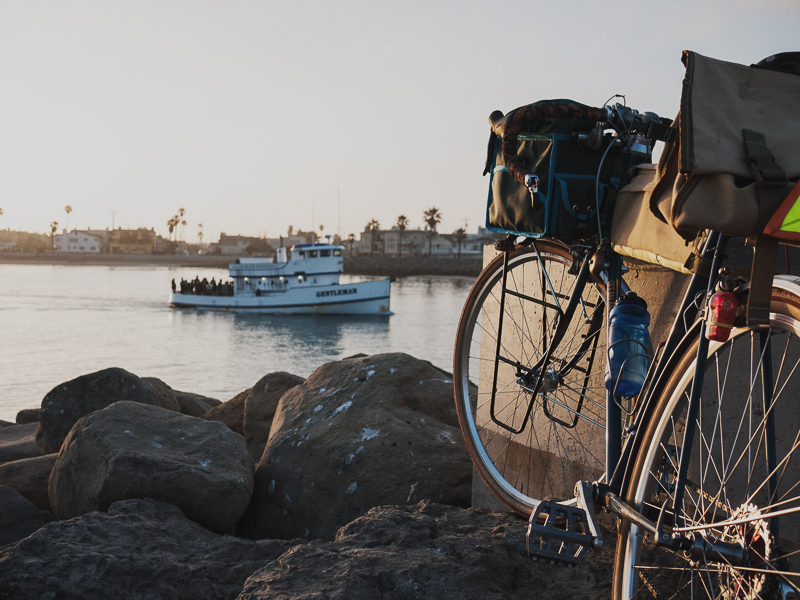

It is good because he motivates for the commute, I get in some extra miles, and some time to hang out and catch up. How is it that life gets so busy that you only catch up with friends, good friends living a few miles from your house once or twice a month? At any rate, these rides are a good thing. Plus we get to watch boats heading out for the day, boil some water, brew up some tea and coffee before he heads on further to work, and I head 11 miles back towards home.

This ride had a testing aspect as well. My new wheel set was delivered yesterday, and there was no delay in getting the Luxos headlight mounted and wired up. Performance in the early morning darkness was fantastic, best light I have ever owned hands down. The ride home gave me a chance to test out the USB charger.

I wish there was something exciting to report, but, well, it just worked. The remote is tucked onto my lamp mount/decaleur and the USB cable is running to the Android phone in the map case. As long as I was moving the phone was charging. Pretty basic, but from what I have read other systems missed the mark. What ever electronic magic B&M cooked up, it works and my first impression is good.
Happy Friday, get out and ride this weekend!
I have made a few successful light mounting bracket out of upcycled chainrings. They work quite well for something that would normally be thrown out or recycled. The upside is that they come pre-drilled, are easily cut to size, easily cleaned up with files, sufficiently rigid to support most lights and are relatively light weight.
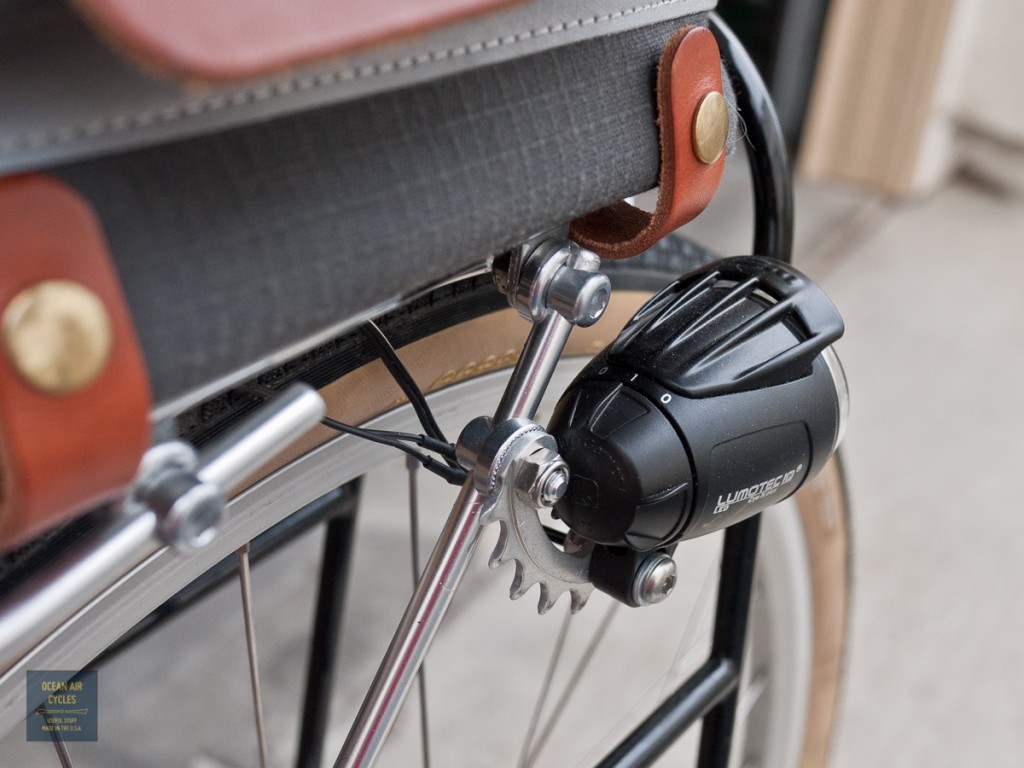
I have a similar solution that I have used with battery mounted lights as well.
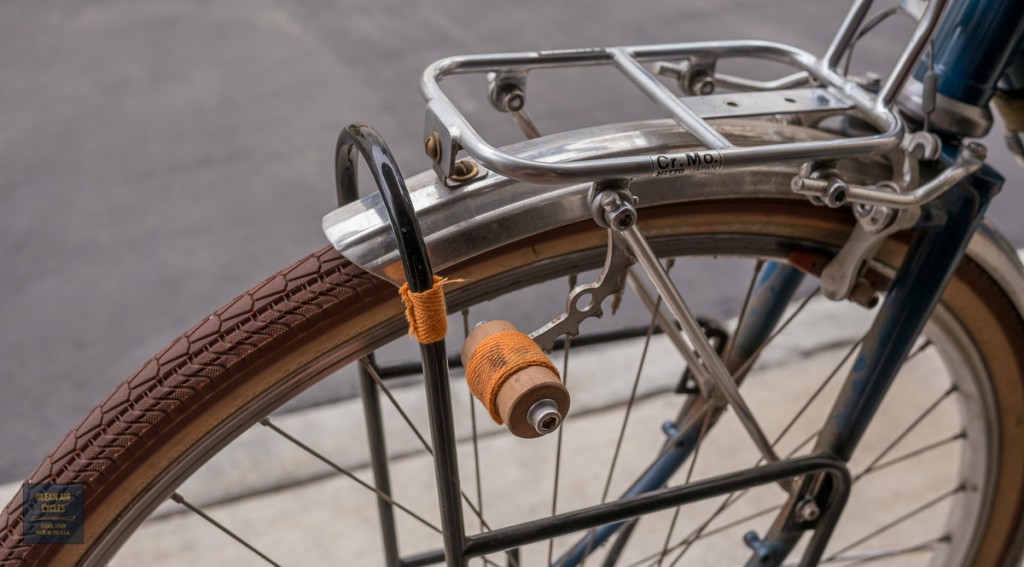
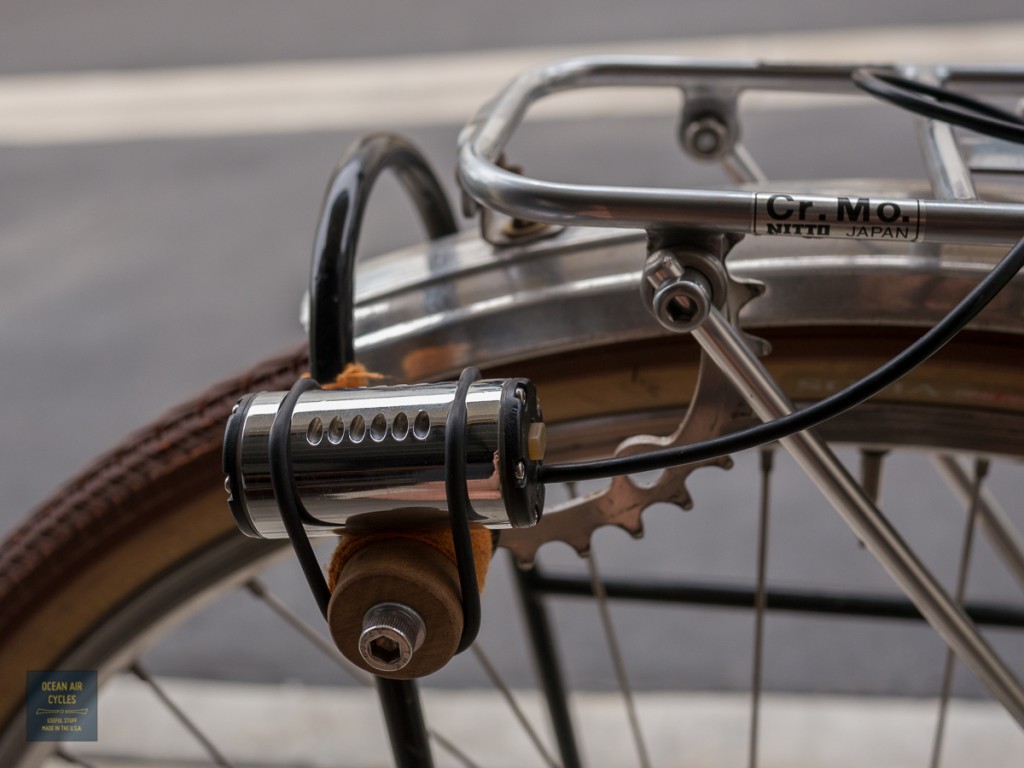
This one has served me well, but as I get ready to switch this bike over to a dynamo lighting system, I thought is was a good time to share the set up. There is a lot that the home hobbiest can do solve challenges like this with basic hand tools and a trip to the local hardware store.
Here is a sneak peak of the mount I am working on for the upcoming dyno system. First step is tacking and filling with epoxy. Next up is a composite wrap. Conventional wisdom is that something like this needs to be brazed. If whole bikes can be built with bonded metal and composite systems, I am sure light mounts can be done just fine.

Next steps are to smooth the filler, clean it up and wrap it with a resin fiberglass matrix. More on that soon.
Just because the days are getting longer does not mean that you are all that less likely to be caught riding in the dark. Riding at the margins of the day is honestly one of my favorite times. Last night was no exception.
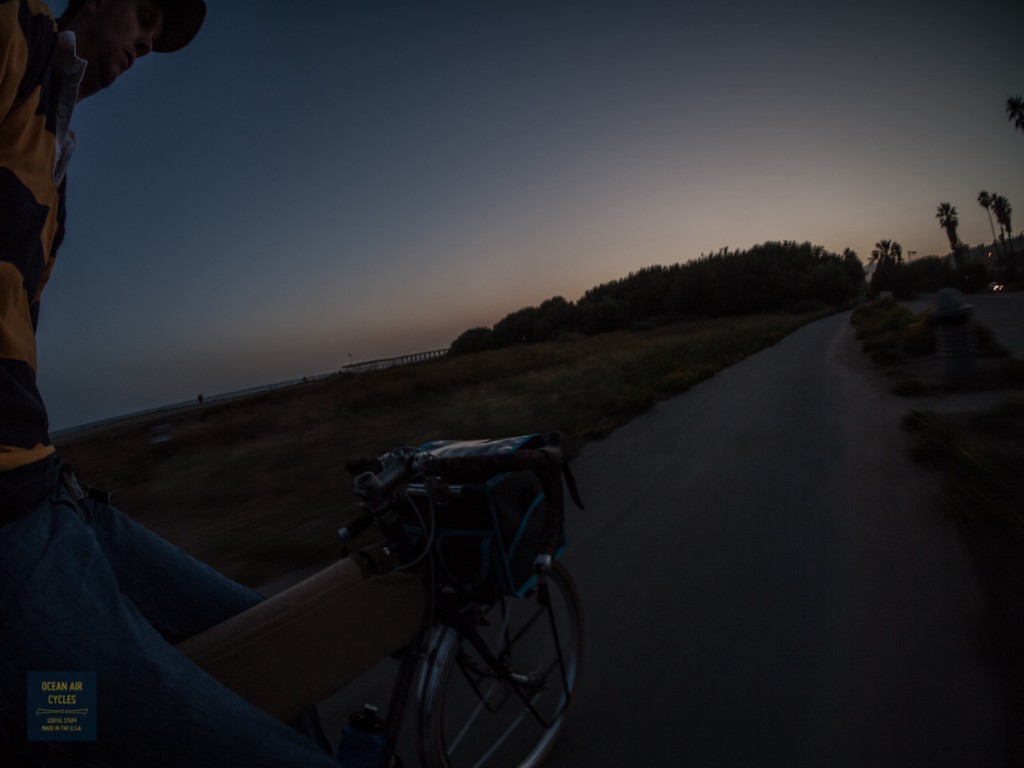
Being visible as well as being able to see are both critical to safety in the dark. I have been getting by still with my old battery powered lights. Even though the
Ramblers are purpose built for integrated lighting, I have been so busy I have not been getting out in the dark. That though is a problem in and of itself, I have been riding less in general, and that is not a good thing. Then comes the new
Luxos from Busch and Muller.

As are many men, I am susceptible to gadget acquisition syndrome. These new lights are the gold standard in hub dyno powered lighting. Not that the previous lights like the B&M Cyo or EDelux are in any way inadequate. But the Luxos throws some serious light at a 70 LUX rating. I have been reading reviews and getting a bit excited to set up one on my Rambler. The Luxos U includes a USB charger to help keep the other gadgets running as well. I ordered a few extra to have some up on the storefront. Now all I need is my wheel that is in progress at
Sugar Wheel Works and it will be time to start riding a bit earlier each day.
This may or may not be what you were thinking. The Luxos from B&M is the hot new light on the market this summer, and for good reason. Higher output, wider beam, and remote switching and USB charger on the Luxos U what is not to like? There have been
plenty of posts and videos on other sites comparing the beam shots of these as well as others. The one thing everybody mentions is that the Luxos is significantly larger than the B&M Cyo. While I was shooting some product photos today it crossed my mind that I had both lights in the workshop, and should makes some comparison shots.
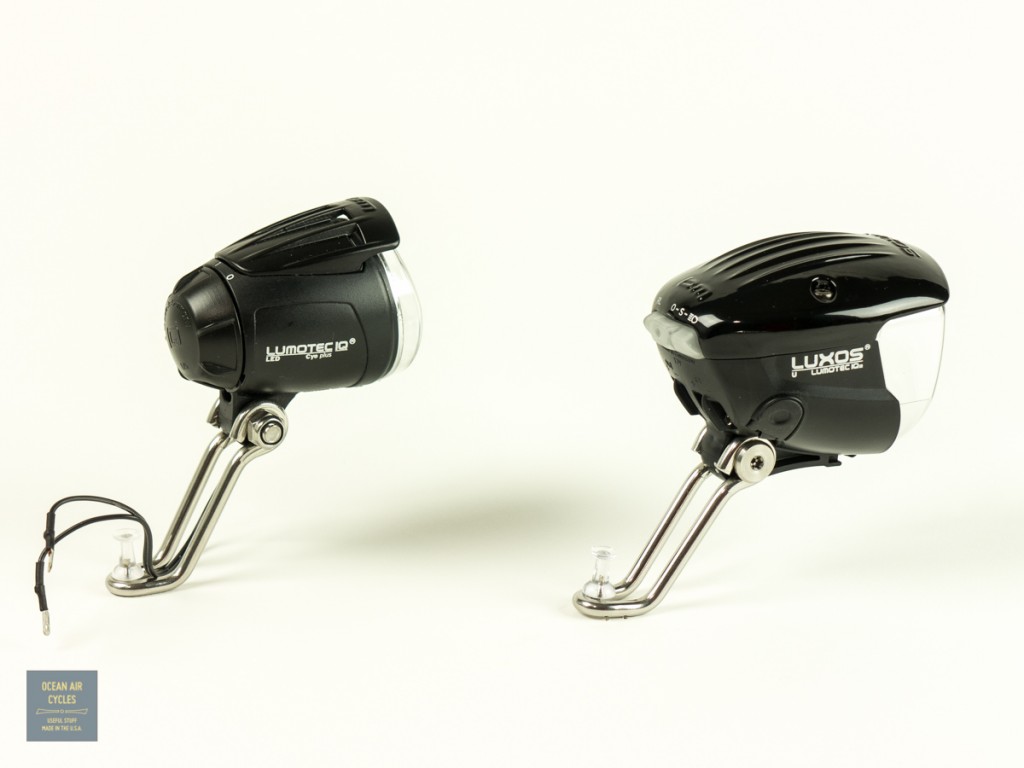

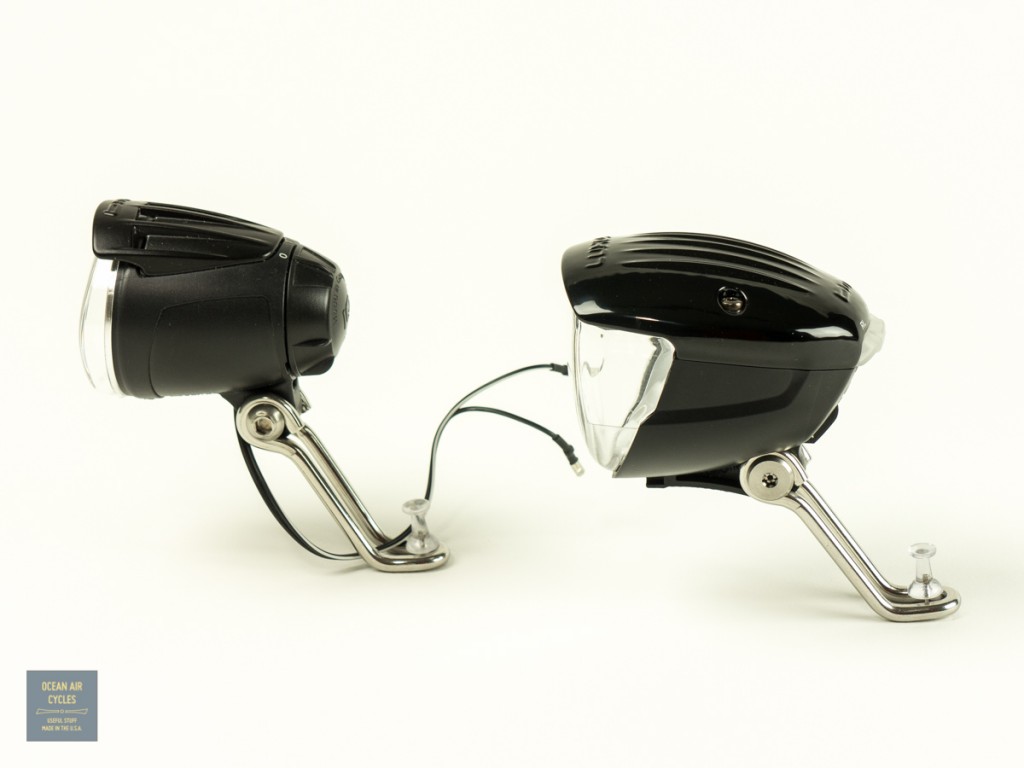

All that extra light comes with a slight price, and I am not talking about the $$ alone. The form factor and heat sink to cool the LED are significantly larger than the Cyo. The luxos is obviously a bigger light, and hits the scales with an extra 50g. That said, I am excited to get my
Rambler wired up with one. The extra light on the road, both to the front and sides will be welcome.
Dimensional Differences for mounting considerations:

I have a couple extra of the Luxos B and U in stock and will be adding them to the
storefront later this week.
I have been having a ton of fun getting out in the mornings to take a little extra time, boil up my water outside and brew up a cup of coffee. I hope that it is inspiring a few of you to do the same. For me it has been mostly for fun, and partially to rack up some quick hours on some sample stoves.

I have been working with
Trail Designs to take some of their basic stove kits and tweak them a bit for cyclotouring. Cylotouring subjects the packed stove to more vibration, jostling and potential crushing abuse than an average hiking trip.
I first heard of Trail Designs a few years back while doing some research on the
backpackinglight forums. As an aside, there is a ton of good information over there on ways to lighten your load while maintaining the comforts you want to bring with you on outdoor adventures. It seems that the alcohol, in many versions, stove the most popular choice, and the king of ready-made systems is the Caldera Cone. These are often custom-made to fit a specific pot or mug, there are a couple of form factor variations as well as aluminum or titanium versions. For the sake of keeping things simple and cost reasonable I started with their
Sidewinder System and
Caldera Keg. Both of these are complete kits that include the pot, cone, stove, and everything short of fuel and water that you will need to get started boiling water outside.
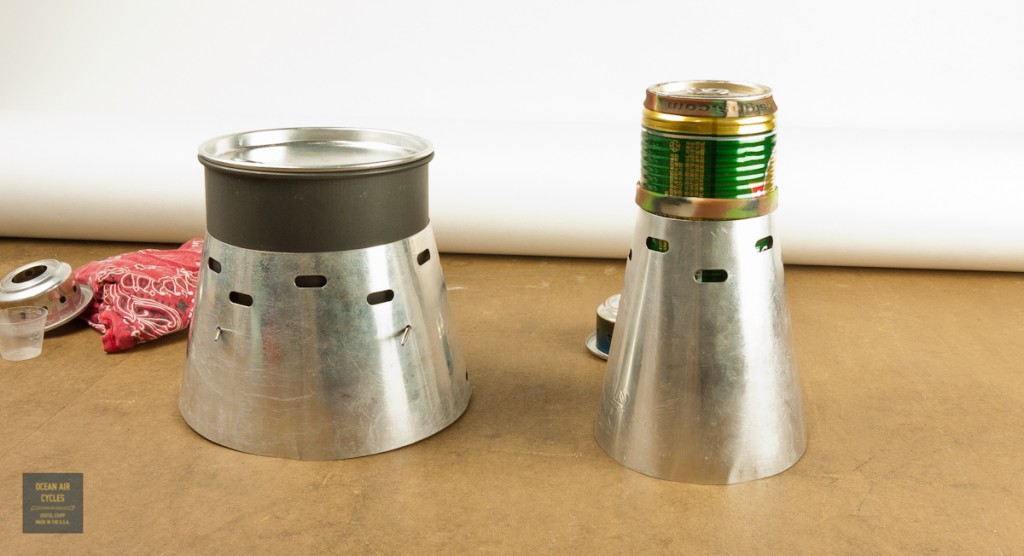
The Caldera Cone system is unique in a couple of ways. The pot stand and wind screen are one in the same. The shape of the cone and location of vent holes focuses the heat, with little waste on the bottom of the pot, contains some heat around the sides, and maximizes efficient burn of the fuel. Efficiency of the burn is huge, resulting in less fuel needed to boil more water, and less fuel that you need to carry. The whole cone / pot assembly sits over the included 12-10 stove.
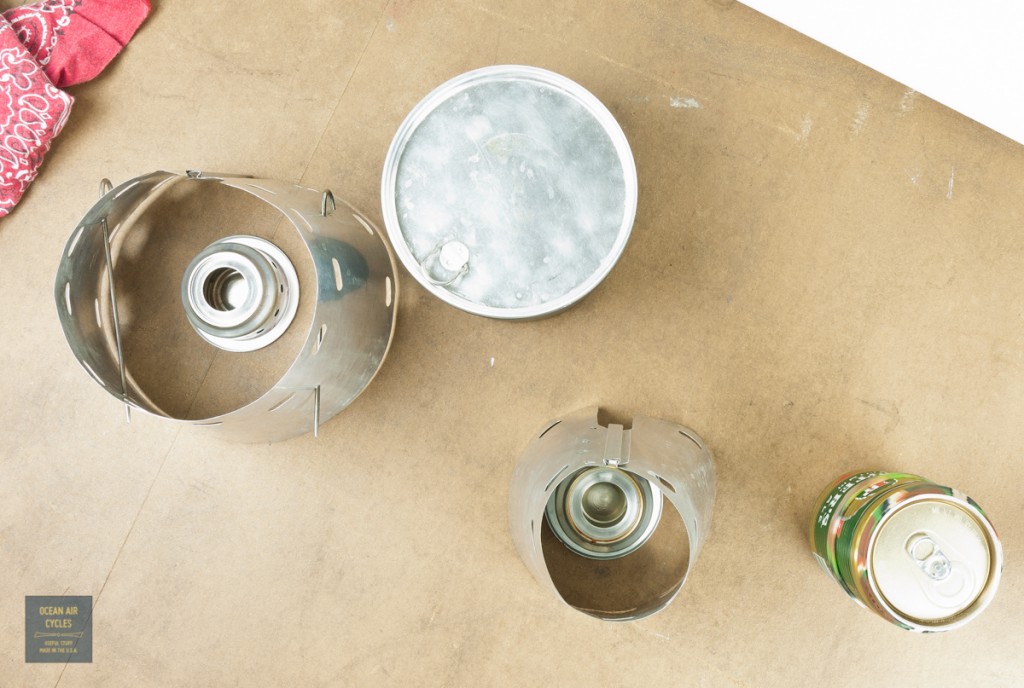
All caldera systems are optimized to work with the 12/10 alcohol stove system. This is an open non pressurized design made from upcycled cans, and a custom integrated priming pan for cold weather

Both systems will bring 24oz of water to boil in a few minutes with about 1.25oz of fuel. The major difference between kits is the volume of the pots, the resulting form factor and weight.
The Keg System is designed around a upcycled Fosters beer can, maxes out with a volume of 24oz of water. The pot has a bulge formed near its center to add strength and a resting point against the top edge of the cone. The Pot, lid and cone weigh a flyweight 84g with the silicone gripper bands in place. The stove is not fragile, but takes some care, and includes a plastic caddy for packing protection.
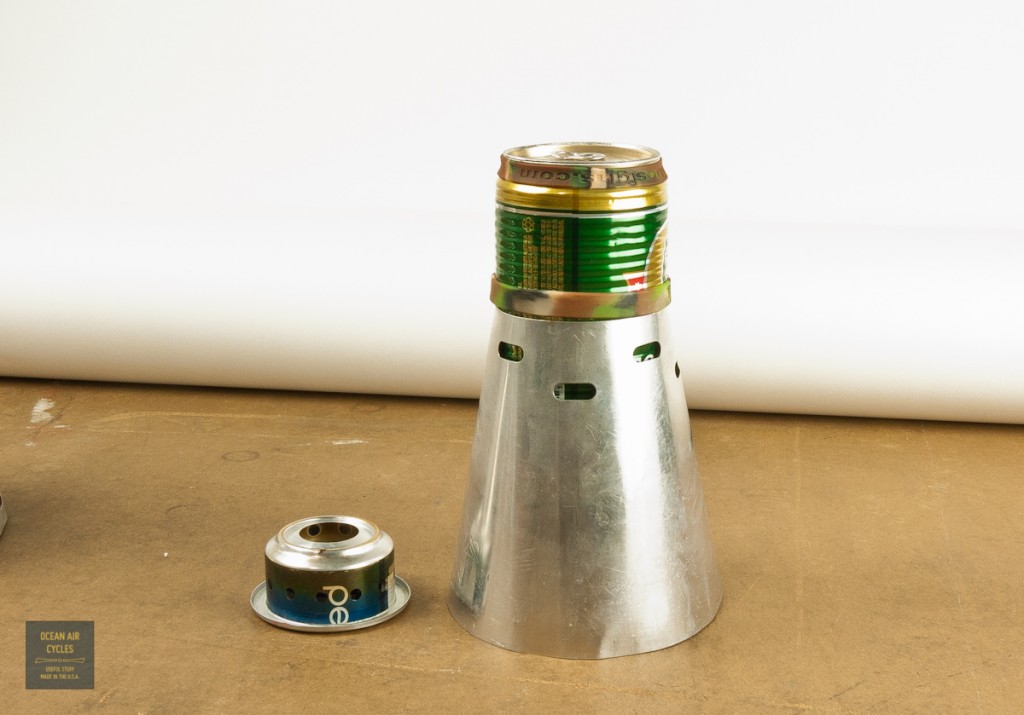
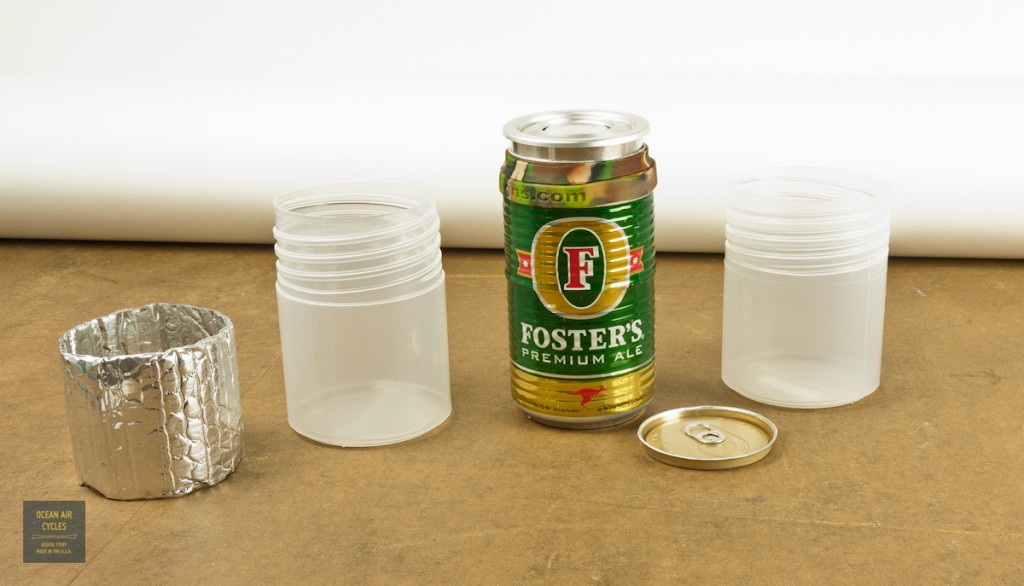
The Sidewinder kit is designed around a Made in In the USA Open Country 2qt Aluminum pot. This is a much higher volume cook set with a 64oz capacity. This comes at the price of weight, 340g for pot lid and cone. While the jump in weight from the keg system seems large, this system is still 220g lighter than the 50oz JetBoil group system. The upside of the weight gain is self-containment of the whole system when packed, and the ability to boil larger volumes of water in one go, e.g. enough for coffee and oatmeal.
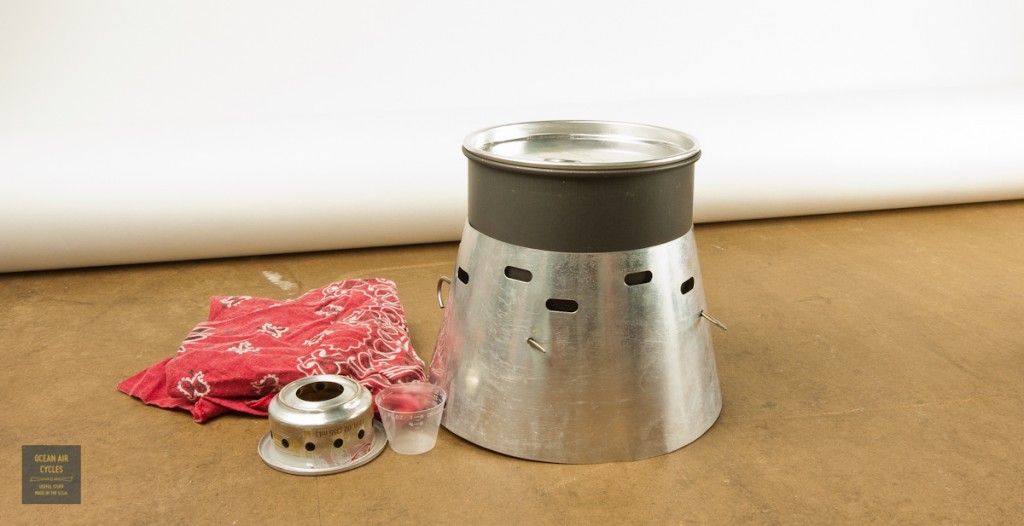
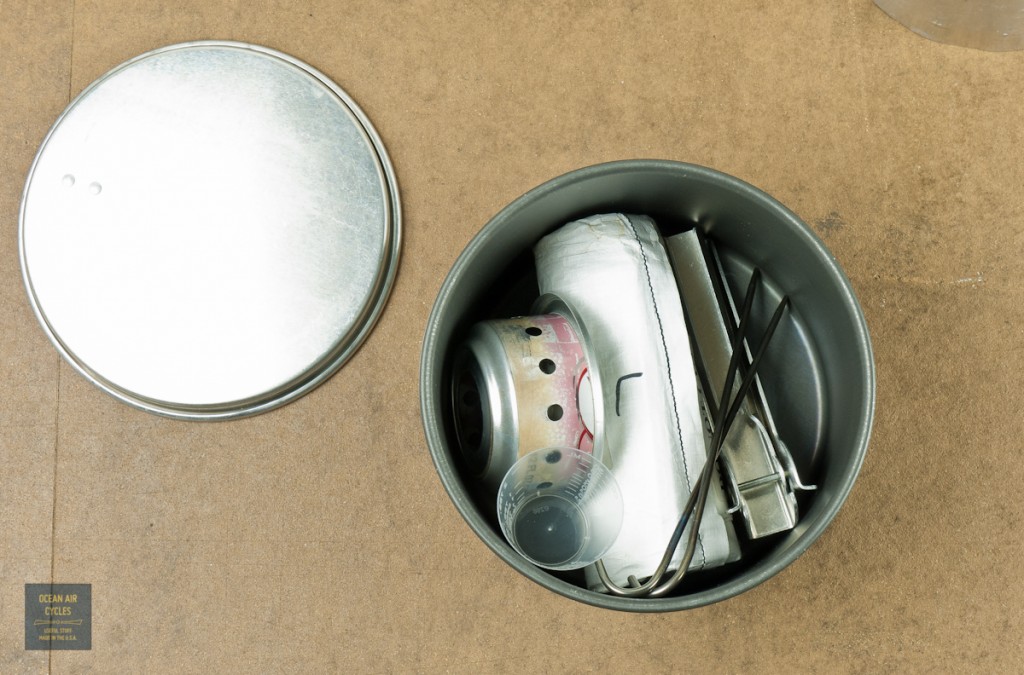
The larger pot has room to spare for my coffee filter cone and some small portions of food if needed as well.

Both of the systems pack up into completely self-contained units. Both are equally portable and significantly lighter than the stove systems you will find at your local outdoor store. Here is the packed up shot with an older 1L Sigg bottle to give you an idea of scale.
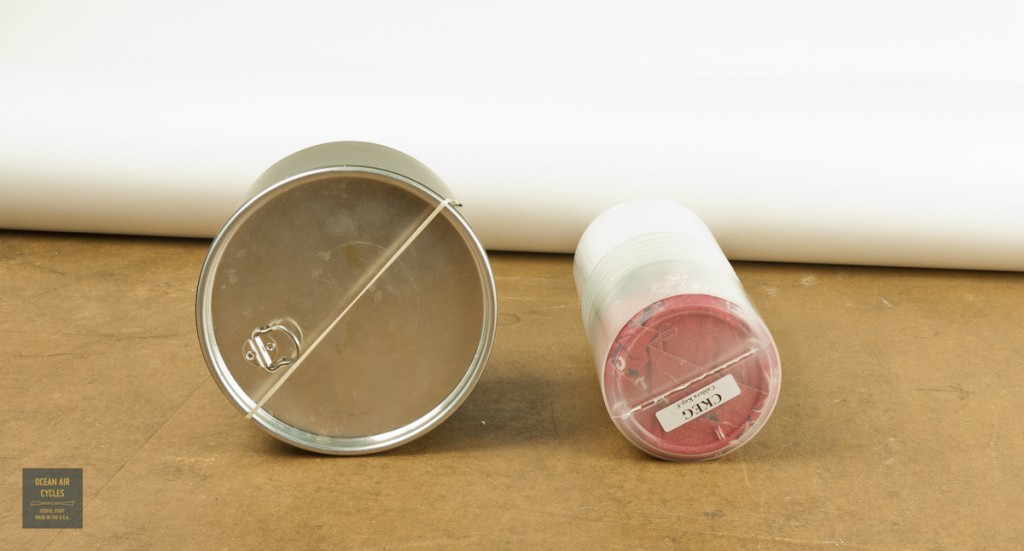

The primary fuel for these stoves is denatured alcohol. It is easily found at most hardware or paint stores. You can also use 190 proof grain alcohol if you are so inclined, and the fuel could also be consumed (as in a drink) in a pinch. The denatured variety is no good for your insides, but great for other things like mixing up shellac or cleaning up grease on your bike.

The kits include an 8oz fuel bottle for managing smaller portions of fuel. The 8oz oz of fuel has been getting me through 6 or so 22oz boils for my coffee and should be more than enough for a weekend or overnight trip. The bottle seals with an o-ring and is slightly squeezy for easy portioning into the measuring cup

If you are going on a trip that might take that little extra bit of fuel you can buy the Gram Cracker stove that holds Esbit tabs. The stove itself weighs in at 7g, and will optimize the burn of the esbit tab. There are slide in wings that will hold one or two tabs in place, and slightly slow the burn rate for getting the most heat out of each tablet.


Having used a bunch of different stoves and fuel systems over the years of camping, I am completely sold on the Caldera Cone system. They are incredibly light and efficient. The stove itself is silent and burns fuel from a renewable source. Fuel can be bought in bulk, cheaply and there is not as many single use throw away containers as with propane systems. Many of the parts in the system come from upcycled waste products, beer and soda cans. The cones and kits are put together by guys doing what they love in the Sierras.
So what would I change with both or either of these kits to make them better? First thing is add a bandana to each one. It has turned out that is all it took to stop the rattling and keep all the components secure in the kits. For the sake of getting started that is how I will be adding these to the storefront. The basic kits plus bandana. If I had to pick just one it would be the larger pot, I like a big cup of coffee, and tend to eat big. If you are used to average sized solo camp cook sets the Keg is a great super light choice, and fits a little better into most bike bags.
In the long run I would like to work on a single kit that splits the difference in volume and weight. I find the Keg system is good for a single portion at a time, and the pot is bigger than I need for most things. Both work just fine, so good that it may be a while until I have the time to throw at making a dream kit. The guys at Trail Designs can put together a huge variety of custom kits if the Goldilocks syndrome is unrelenting. They also have a titanium version that opens up the option of burning wood for fuel. The Ti is a great system as well, but does come with some tradeoffs, that will take another post though.
When we were working on this project it became apparent that sourcing pots consistently is the biggest hurdle, and the pot is the backbone of the system. Until I have the pot portion sorted out there will be the two basic kits.
Keep an Eye on the store front, they will be going up in the next couple of days.
The stove systems are up now
Caldera Sidewinder Kit
Caldera Keg Kit
Lately I have been getting some inquiries about the pole cam system I was/am using to get some of the shots I was with the GoPro camera over the last couple of years. I worked out a portable system that would allow me to shoot point of view style, but from angles away from the body and not having the hand holding the camera in the shot. There were quite a few revisions. Most of them worked just fine, but the overall length was best carried in a frame bag. To overcome that I ended up segmenting the pole. Here is a peak at my latest compact version.
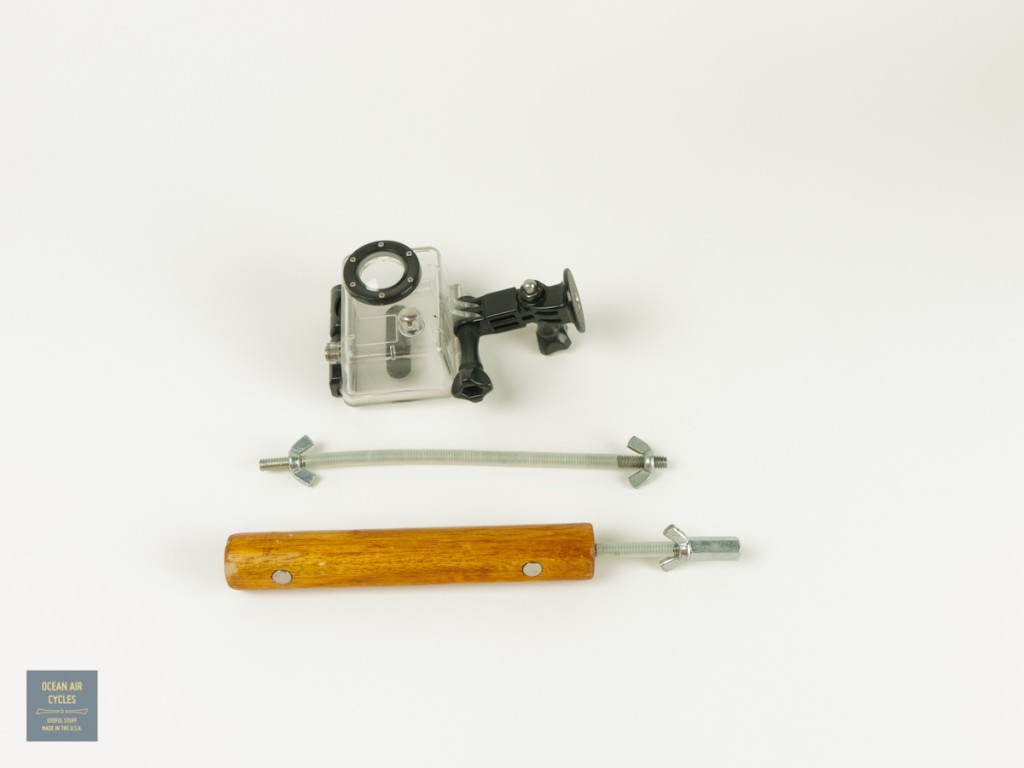



Key Features:
- The pole moves the GoPro about 12 inches from your hand
- The pole breaks down into sections about 8 inches long
- Additional extension pieces can be used for added length
- 1/4" 20 threat will work with existing camera tripod mounts and accessories
- Rare Earth magnets in the handle allow for quick mounting to sign posts, fence rails, guard rails, etc. The world is your tripod
- Hand shaped wooden handle with flat side for indexing camera orientation and durable shellac finish
As with a bunch of things these will be added to the storefront in the coming weeks, with a street price around $30. If you are interested drop me an email through the contact page.
As for capturing the images, I set the camera to grab stills every 2 seconds, trigger it, hold it out to get a series of shots, then turn it off that simple. It is the same basic process for video or riding past it mounted to something. An easy and portable way to get more creative shots with you GoPro while on tour this summer.

I believe Bandannas are the second most under rated thing everybody should have with them at all times, second only to a really good pocket knife. I always have one or more at hand, in the pocket, bike bag, or in the mess kit.
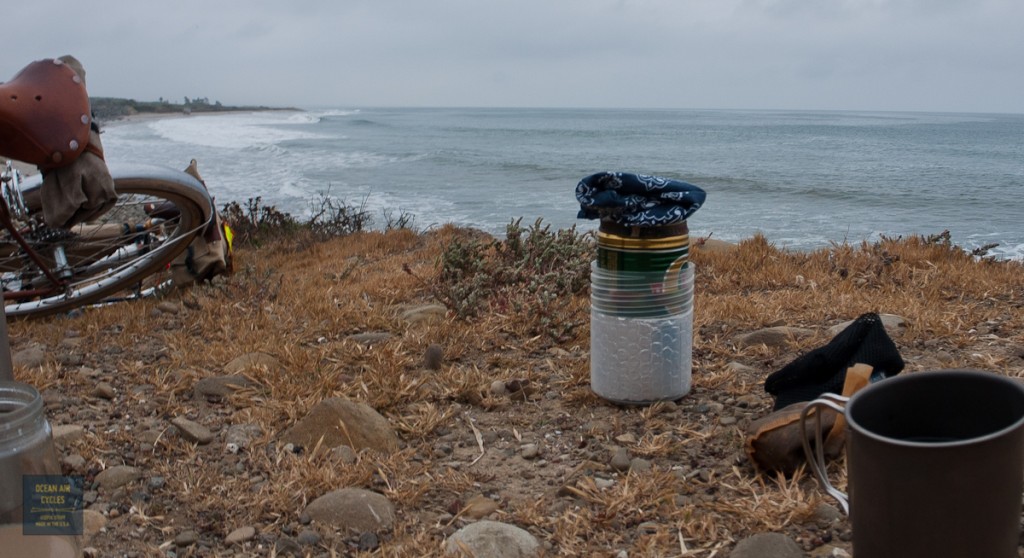
The Paisley bandanna is the traditional kerchief used by our grandpas and their's before them. A 21x21 inch square of 100% cotton being the most useful accessory you can keep with you every day. Like a pocket knife that is with you every day, you will eventually wonder what you were doing before you had these. Things I use mine for: Handkerchief, napkin, pot grabber, bandage, rag, shade for your neck, sweat band, bandage, stop that something from rattling in your bag.....on and on.
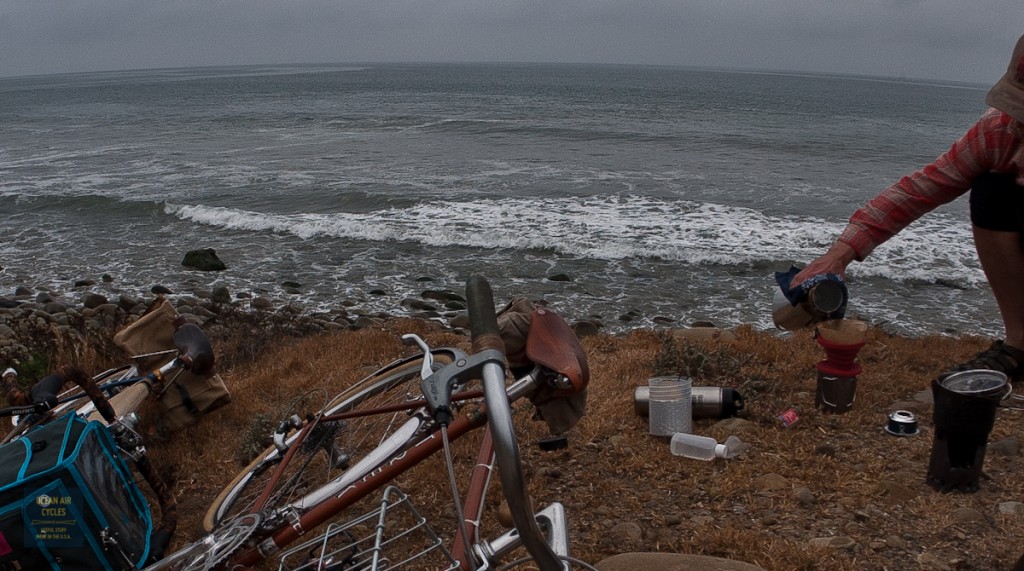
These are made in the Carolinas by one of the last remaining bandanna companies in the USA. 100% cotton, dyed, printed, cut and edges sewn here, keeping jobs here. The "Traditional" bandannas are mill fresh and start out crisp and stiff. A few trips in your pocket and through the laundry will get them soft. For that extra bit of instant gratification we also have "stone washed" bandannas that are silky soft right from the start.

Like many thing you can never have too many, always one in your pocket, one in you bike bag. Making the transition you will be amazed how much longer the roll of paper towels and box of tissues will last.
As with everything that ends up on the storefront, it is there because I use it, and am pretty sure other people do to. You can find the bandannas by clicking the pic above or
here.
Note: if you have kids you may end up needing more than one a day, trust me on this.
I have been riding flat, non retaining system, pedals for a long time. Most of my youth, and for recent years thanks to Grant at
Rivendell, I have been pedaling free. There are a variety of options at the full range of price points. At the lower end you can get very basic touring or BMX pedals with decent traction for $20. The upper end is dominated by very thin machined aluminum mountain bike race pedals these go well up into the $hundreds with exotic materials in the pursuit of weight savings and thinness. I have been testing a range off offerings in pursuit of offering a pedal that strikes a balance of performance and value.
What are things I consider key?
- Wide and long platform for maximum foot support. This puts much of the stiffness burden back on the pedal and reduces or completely removes the need for stiffness in the shoe.
- Traction pins that are integral to the design, easily replaceable and in useful places. The pins keep you foot from slipping off of the pedal. There are lots of types, from cast in to screws that come in from the top or bottom.
- Sealed Cartridge bearings. This is where the price can go up fast compared to basic pedals. While most pedals can be serviced and last a life time, good seals and bearings increase the time between servicing as well as the ease of the process.
- Thinness. As downhill and dirt jumping have dominated this pedal market segment the pedals keep getting thinner. Older pedals are generally 25-30mm thick. The newest versions are 5-15mm thick. Thinner pedals get you closer to the ground. The change of center of gravity is probably insignificant, but you are 5-10mm closer to the ground and that helps to get more than the tip of your toe on the ground at a stop while your rear is still on the saddle. The truly ultra thin pedals generally make compromises in the bearing and spindle design to achieve the thinness.
Most pedals in this category are coming from overseas at this point in time. US made pedals are out there, but come at a high price and limited options. For now I have been looking at the imports.
The line that struck the best value when considering price and the above key elements was VP Components, and two pedals in particular the VP-001 and the Vice
[caption id="attachment_3667" align="aligncenter" width="640"]

Red VP001 and Blue VP Vice[/caption]
Both are good pedals for about $65-70 street price. Both are a bit wider than some other common pedals, MKS Grip King (lambda) and RMX "sneeker" pedals, as well as have more aggressive pins. The following comparison pictures tell the story.
[caption id="attachment_3669" align="aligncenter" width="640"]

Red VP001 and Blue VP Vice[/caption]


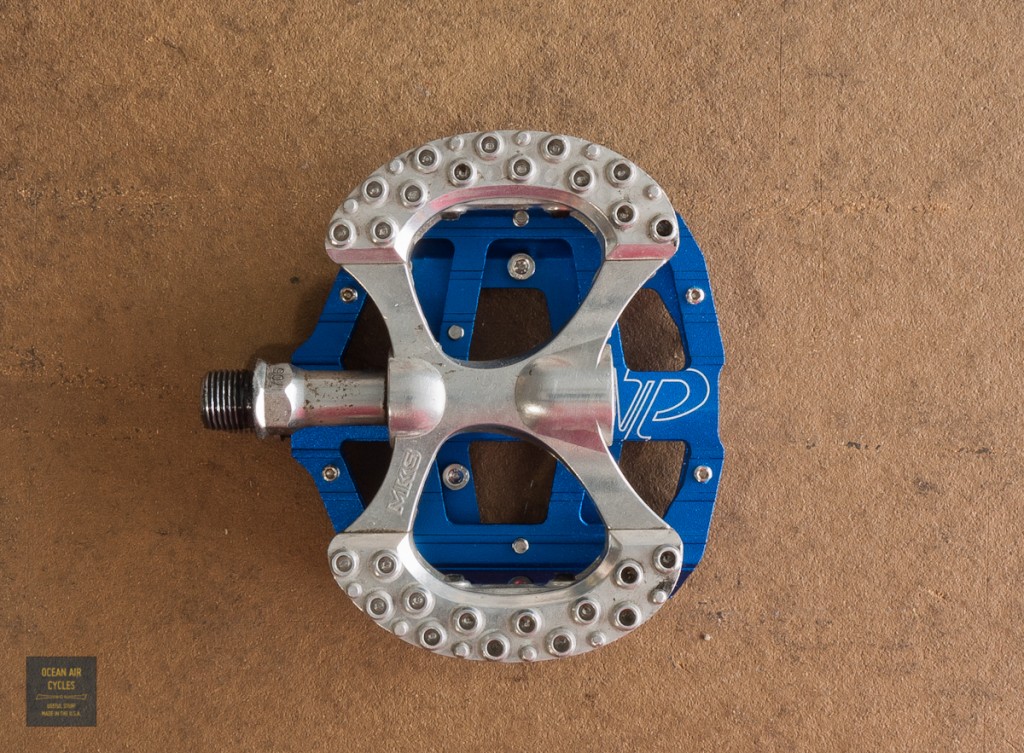
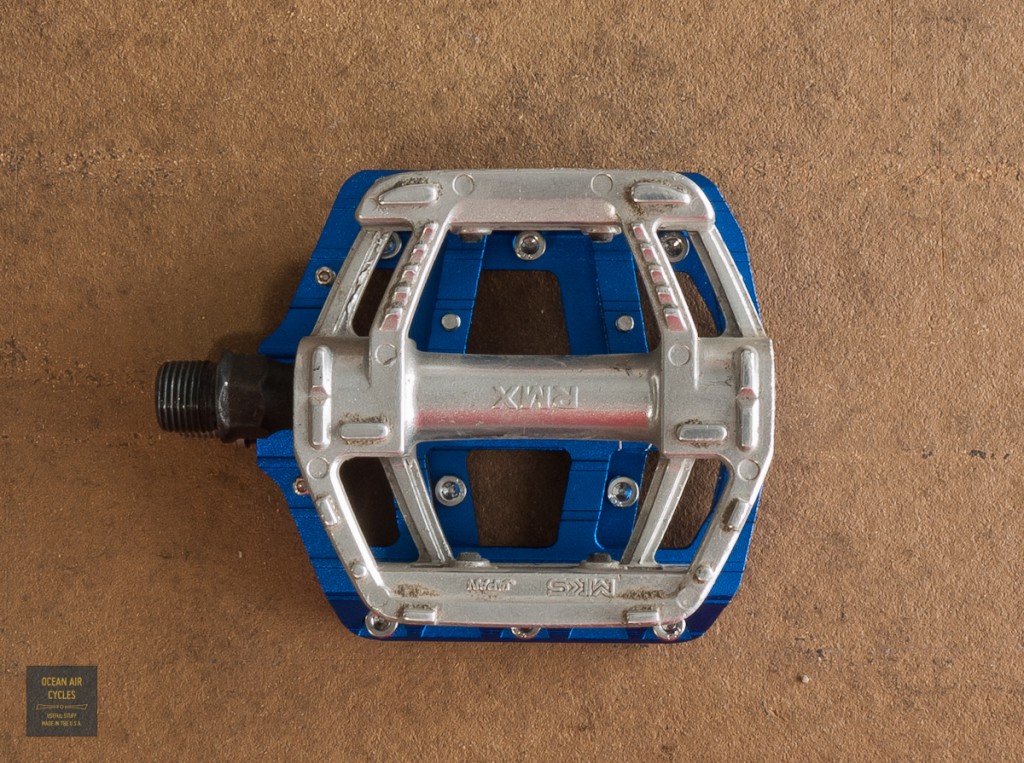 The difference in thinness is remarkable. The MKS pedals are 26mm while the VP are 16mm. The means your saddle height will come down 5mm and your toe will me 5mm closer to the ground at a stop without bringing the pedal any closer to the ground or threatening a strike.
The difference in thinness is remarkable. The MKS pedals are 26mm while the VP are 16mm. The means your saddle height will come down 5mm and your toe will me 5mm closer to the ground at a stop without bringing the pedal any closer to the ground or threatening a strike.
[caption id="attachment_3682" align="aligncenter" width="640"]

Red VP001 and Blue VP Vice[/caption]
There are also some subtle but important differences between the VP-001 and the Vice. For me the Vise is the clear winner. The VP-001 has a more traditional spindle that allows the pedal to be installed with a 6mm allen wrench or traditional 15mm pedal wrench. The Vise on the other hand requires a 8mm key. Why the difference? The vice allows the whole platform to sit closer to the crank arm, and thus your foot closer reducing the overall Q-factor. Q is the distance between crank arms, narrower Q generally feels more normal, and is used in traditional road biking designs.
[caption id="attachment_3668" align="aligncenter" width="640"]
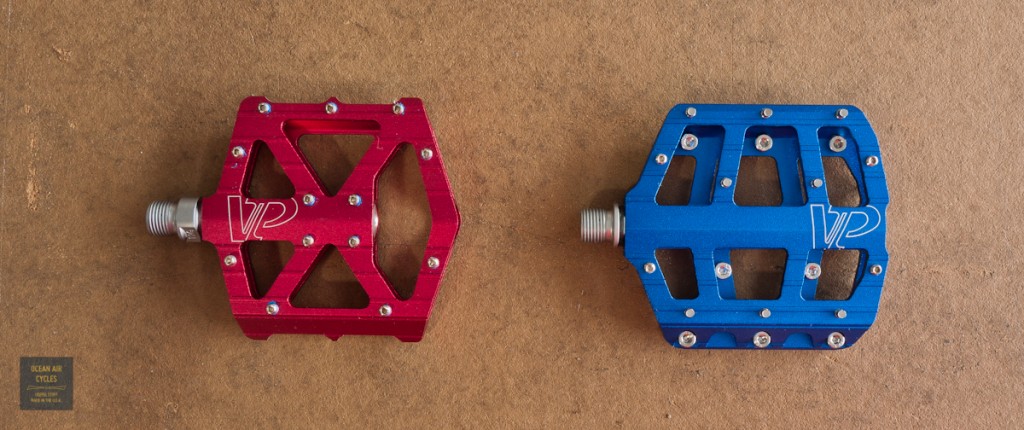
Red VP001 and Blue VP Vice[/caption]
The platforms are both quite large compared to traditional pedals. Compared to each other the Vice has more supporting area at the outer corners as well as through the center of the platform.
[caption id="attachment_3670" align="aligncenter" width="640"]

Red VP001 and Blue VP Vice[/caption]
[caption id="attachment_3671" align="aligncenter" width="640"]
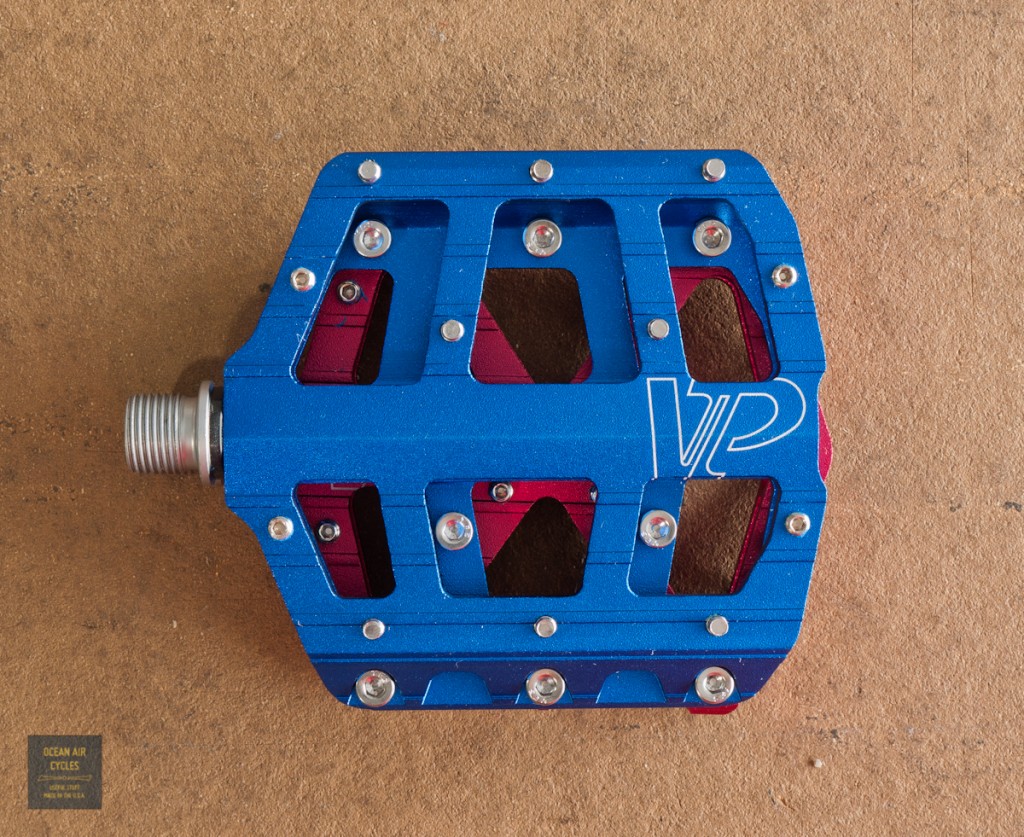
Red VP001 and Blue VP Vice[/caption]
The axle on the Vice is longer and the outboard bearing is placed a full 2cm further out board from the crank arm. This will reduce the loading on the bearing reducing wear and time between service.
[caption id="attachment_3678" align="aligncenter" width="640"]
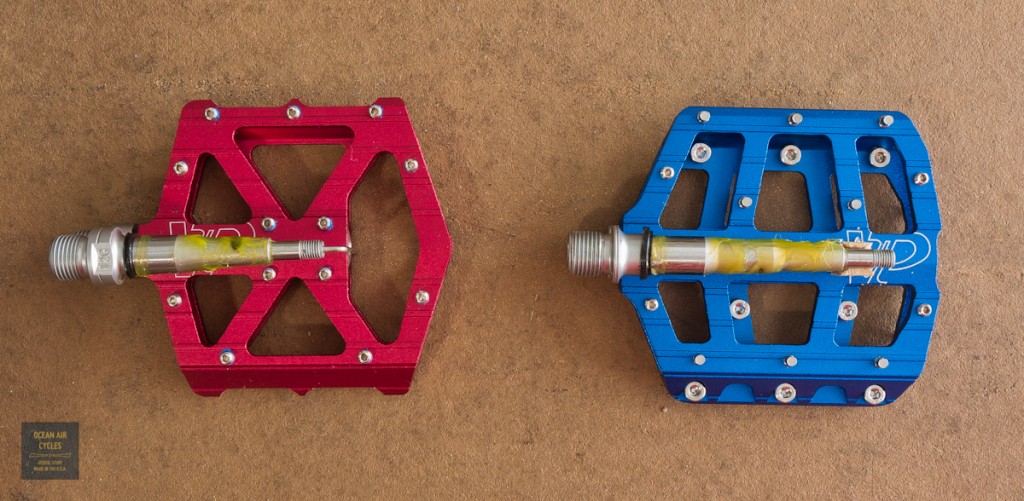
Red VP001 and Blue VP Vice[/caption]

The last and a notable difference is the type and placement of the pins. The VP-001 uses grub or set screws that are inserted from the top. The hole for the wrench to remove and replace these can clog with crud and or be damaged from impact increasing the difficulty of replacement. The Vice uses a combination of M4 bolts that come in from the underside of the platform and the above mentioned grub screws. You can get rid of the grub screws and still have plenty of traction for touring and road riding. The M4 bolts allow a better platform for replacement or tinkering with different lengths etc. The stock M4 bolts are custom ground into pins,
replacements are available, but an average M4 bolt from the store will work fine.

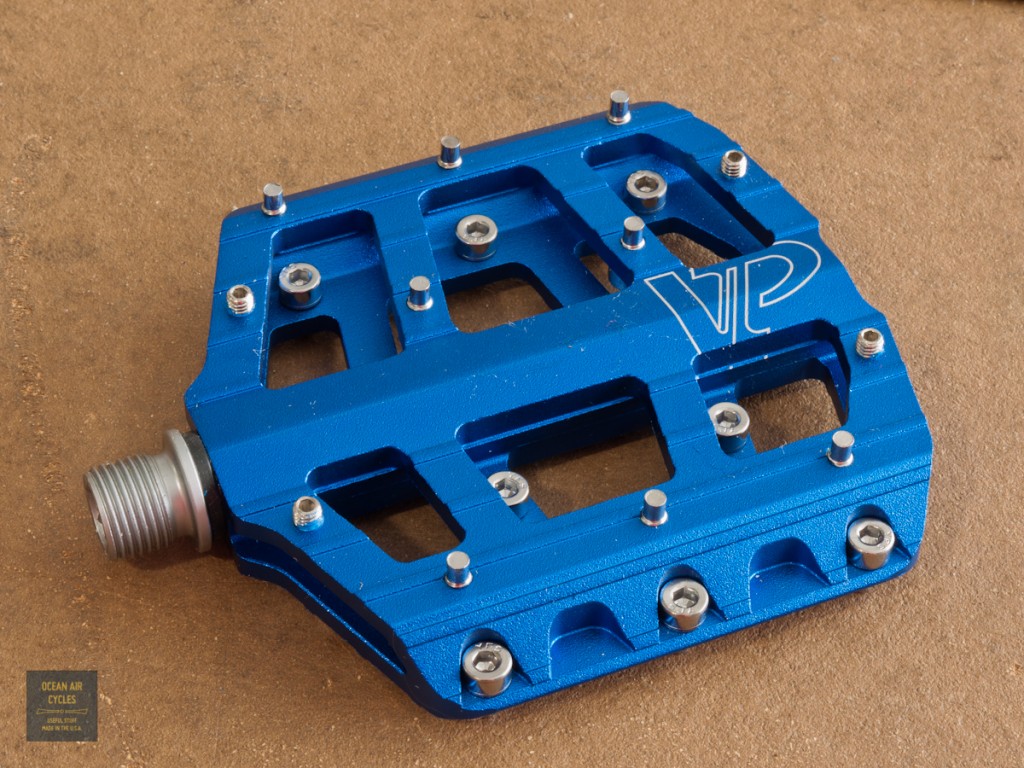
The things that I see as improvements in the Vice over the 001 do come at a price. The Vice is 28-30g heavier per pedal and the price is $5 more. For the truly weight conscious there are
Ti replacement spindles that will shave 35g per pedal. Fine tuning the pins could sheave even more. While both pedals are well overbuilt for street riding and touring, the added value of the Vice makes it the standout in my mind.
Bottom Line....I have been loving my pair of vices, plan on riding the heck out of them for a long time and will be adding the Vice pedals to the storefront this afternoon.
Ride free in the shoes that you like to walk in, it makes it more fun to ride to the places you are going during the day. The change in riding speed really is insignificant from the majority of us, and did I mention that you are likely to have more FUN?
It has been a busy run here, and this week had some more incoming tools I want to test out.

The easy one is the new silicone folding coffee cone. I have been looking for something a bit more portable that does not weigh a ton, and can squeeze into my cook kit. we will see how it goes.
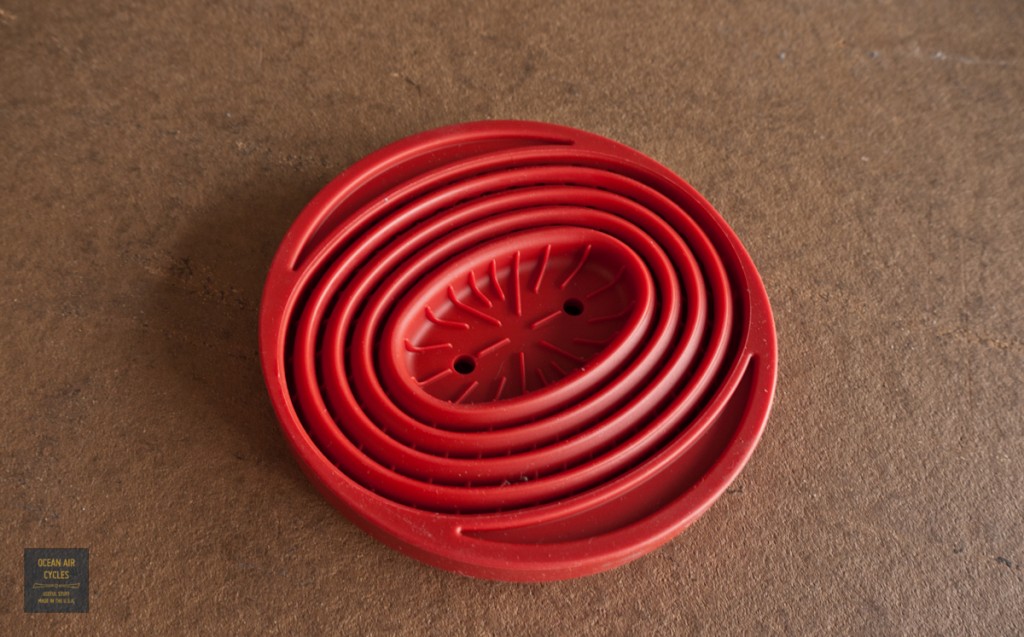
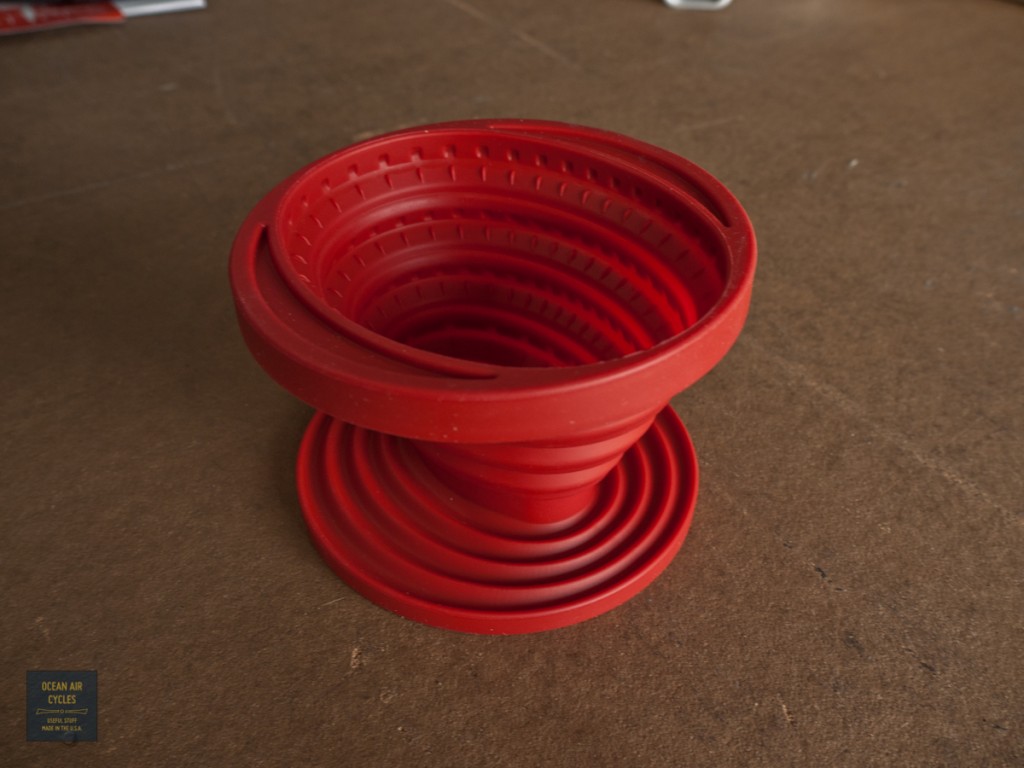
The other tool is a bit more interesting. The
Fix it Sticks are an interesting twist that I hope to have replace my long carried Alien tool.
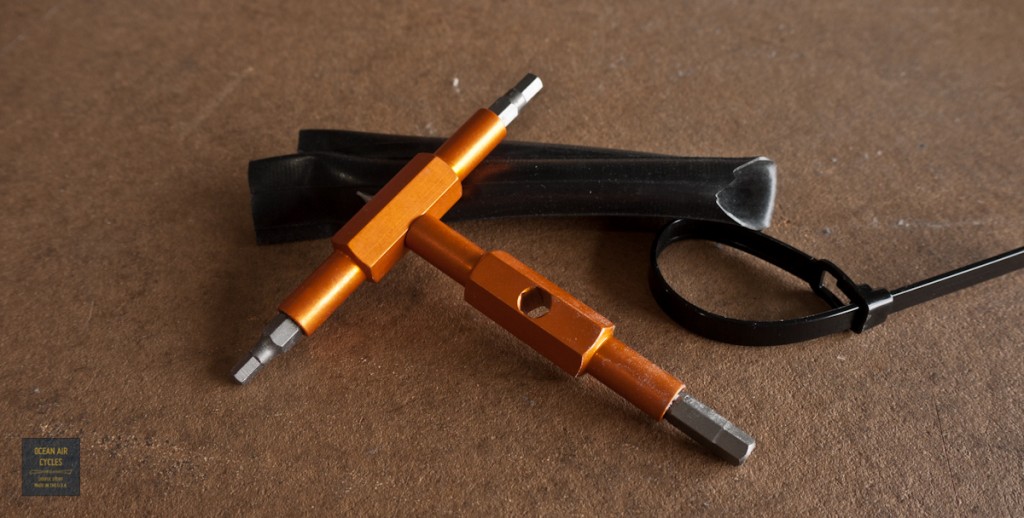
They ran a successful Kick starter campaign to get these things out into the world. They have even more tool options, but I stuck with the basic 4/5/6 since that is what I needed. Hopes are high for these. The tool bits are press fit with an epoxy as backup. the body of the tool is aluminum and lighter than you night expect. For the range of torques needed on the bike they should be more than robust enough, time will tell. They take up about as much room as a set of tire levers and pack up neatly and rattle free in a upcycled tube
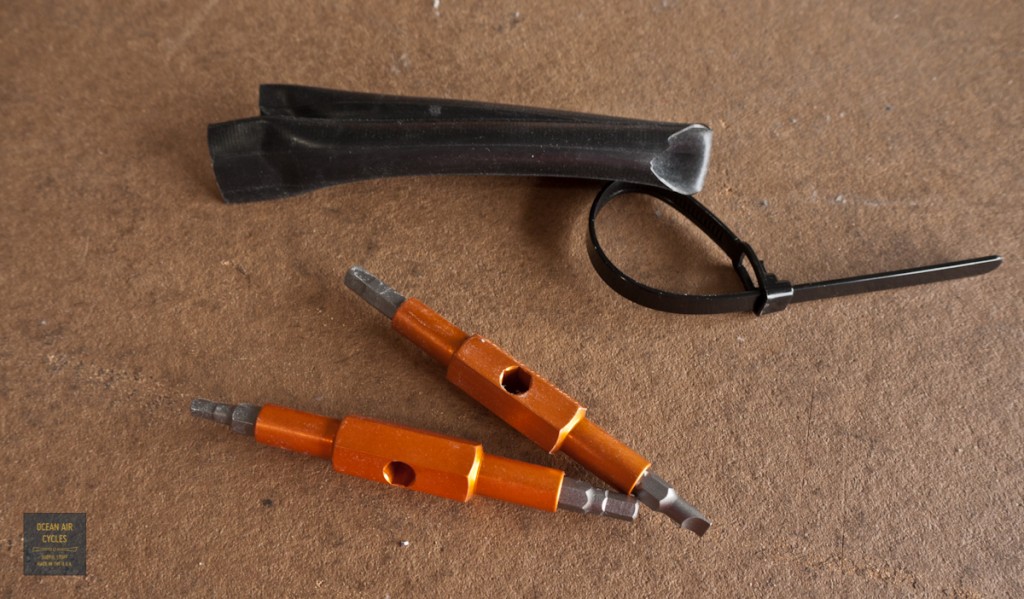

Thinking about how light they felt, and how heavy my decades old Alien tool felt I decided to pull out the scale (a task reserved only for shipping around here most of the time)
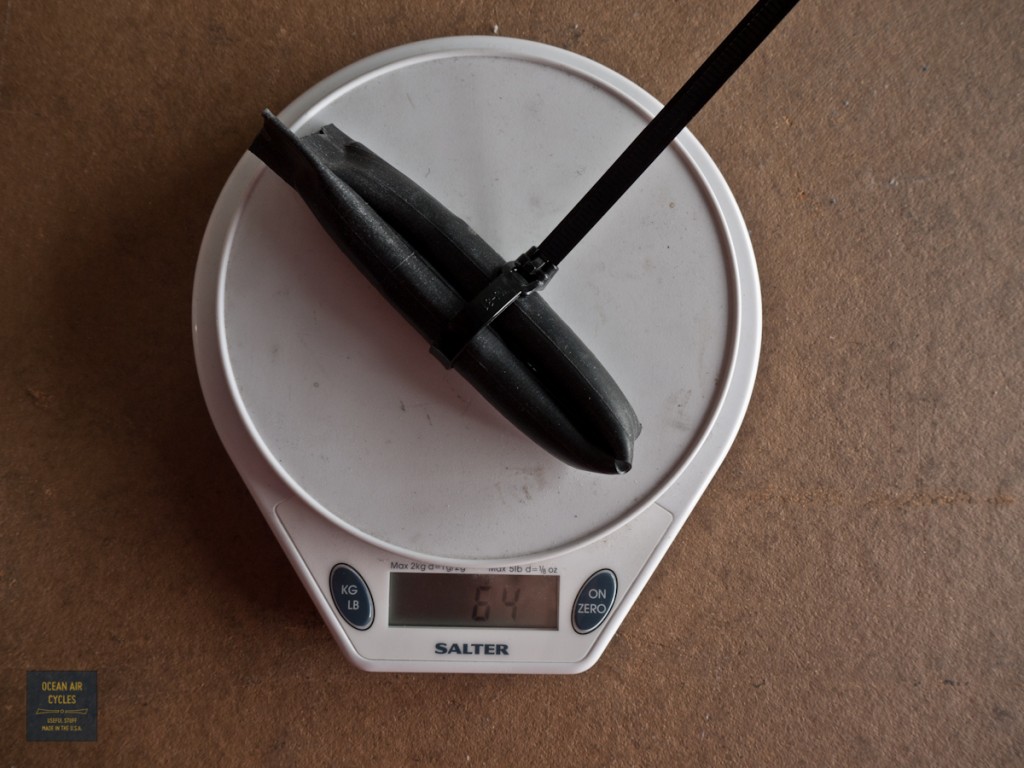
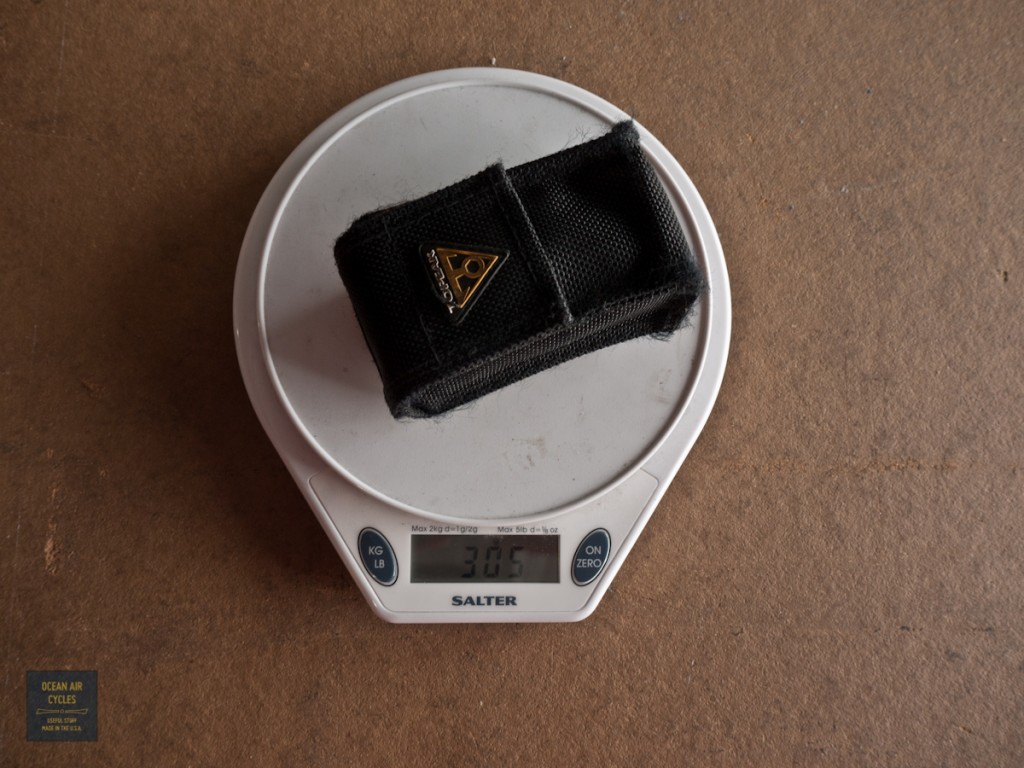

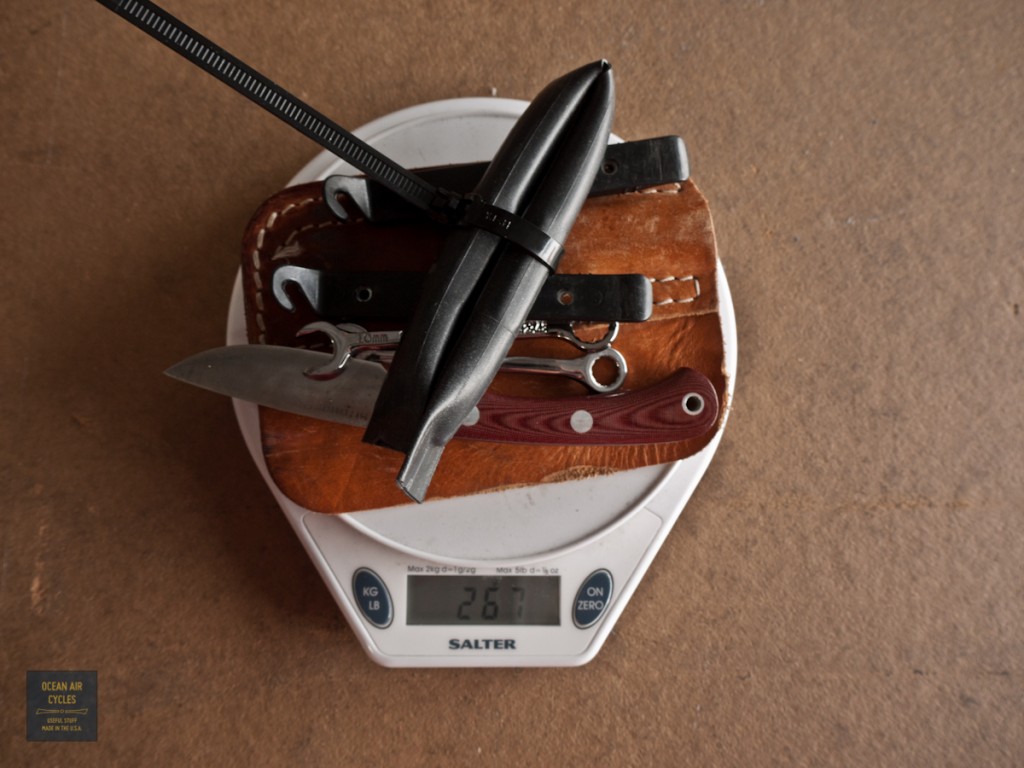
Comparing the pile of tools to the alien it looks like I will shave about 38 grams. While that is just a little bit, there were a ton of redundancies between the Alien and the rest of the tools in that pile I often carried any way. Whey these neat little sticks will really do is convince me to jettison the 305g multi tool and eventually the backup allen keys, shaving almost 3/4 of a pound in the long run.
While that may sound like no big deal in a world of weight be damned bike touring, it means that I can effectively add my camp stove and cooking kit to the bar bag at all times with no weight penalty. That is the point of counting the grams! it is possible to carry the things you want and need without massive panniers and or a super stout bike. With careful selection of your gear you can quite possibly have you comforts and not need a sherpa (or a car) to haul it around. I am not cutting the handles off of my tooth brush, yet, but I am starting to think more about the stuff I haul, and what it weighs.
Enter the Rambler, light weight touring, and some fun.
 I had already gotten my sample Luxos wired up and going when I became aware of the issue with a grounded tail light. At first I was a little bummed, then the challenge was set, and I decided to figure out how hard this was going to be to fix. It turned out to be fairly simple, and I have outlined the steps here for you.
You will need a few basic tools: small flat head skew driver and small wire cutters will get you there, cir-clip pliers and a small Phillips head screw driver help make things a little easier.
I had already gotten my sample Luxos wired up and going when I became aware of the issue with a grounded tail light. At first I was a little bummed, then the challenge was set, and I decided to figure out how hard this was going to be to fix. It turned out to be fairly simple, and I have outlined the steps here for you.
You will need a few basic tools: small flat head skew driver and small wire cutters will get you there, cir-clip pliers and a small Phillips head screw driver help make things a little easier.
 The first thing I did was remove the nuts and washer from the mounting screw. The first is the standard hex mounting nut. Then there is the round washer style nut that holds the bolt to the light body
The first thing I did was remove the nuts and washer from the mounting screw. The first is the standard hex mounting nut. Then there is the round washer style nut that holds the bolt to the light body
 You can get this one off by carefully pushing it around counter-clockwise with the tip of your flat head screwdriver, but the cir-clip pliers made it a little easier.
You can get this one off by carefully pushing it around counter-clockwise with the tip of your flat head screwdriver, but the cir-clip pliers made it a little easier.
 Once done you will be opening the light housing. Carefully work your way around the edges, starting from the bottom. The two halves of the housing are a press/snap fit together and can come apart safely as long as you are careful. I inserted the tip of the screwdriver into the thin gap between housings and lightly twisted to get it going.
Once done you will be opening the light housing. Carefully work your way around the edges, starting from the bottom. The two halves of the housing are a press/snap fit together and can come apart safely as long as you are careful. I inserted the tip of the screwdriver into the thin gap between housings and lightly twisted to get it going.

 As you approach the top you need to be extra careful. This is where there is a small tab that indexes the two halves together. At this point I stopped using the tool and gently separated the two halves with my hands
As you approach the top you need to be extra careful. This is where there is a small tab that indexes the two halves together. At this point I stopped using the tool and gently separated the two halves with my hands
 Once opened, you can easily see the above mentioned plastic tab.
Once opened, you can easily see the above mentioned plastic tab.
 Moving on to the grounding of the light. The Seculite plus has two possible grounding paths. For most common installations involving a B&M headlight you will be wiring the tail light tot he front with a paired or co-axial conductor. The other grounding path is through the mounting screw. This is only used in cases where the frame of the bike and associated hardware are used as the grounding path. looking at the circuit board you can see both of the internal grounding wire options on the left side. The single wire on the left is for the positive lead.
Moving on to the grounding of the light. The Seculite plus has two possible grounding paths. For most common installations involving a B&M headlight you will be wiring the tail light tot he front with a paired or co-axial conductor. The other grounding path is through the mounting screw. This is only used in cases where the frame of the bike and associated hardware are used as the grounding path. looking at the circuit board you can see both of the internal grounding wire options on the left side. The single wire on the left is for the positive lead.
 The grounding wire to the frame mount needs to come out. It is connected to the mounting bolt with a ring connector. I was able to get the bolt out of the housing with the LED circuit board in place. If this is too tight for your comfort, you can remove the two Phillips head screws securing the board to the housing and you will then have plenty of room to work.
The grounding wire to the frame mount needs to come out. It is connected to the mounting bolt with a ring connector. I was able to get the bolt out of the housing with the LED circuit board in place. If this is too tight for your comfort, you can remove the two Phillips head screws securing the board to the housing and you will then have plenty of room to work.

 With the board out, you will want to snip the wire with the ring connector as close as you can to the board.
With the board out, you will want to snip the wire with the ring connector as close as you can to the board.
 In theory you could leave the connector inside and isolate it, wrap it in electrical tape or shrink wrap, so that the process could be reversed. For this light I am pretty certain that it will never be wired with a frame ground path, so I snipped. While I had things appart I wired the Seculite into the Luxos U and confirmed that everything was as hoped.
In theory you could leave the connector inside and isolate it, wrap it in electrical tape or shrink wrap, so that the process could be reversed. For this light I am pretty certain that it will never be wired with a frame ground path, so I snipped. While I had things appart I wired the Seculite into the Luxos U and confirmed that everything was as hoped.
 The re-assembly is a pretty straight forward reversal of the above steps. Double check that the remaining wire connection points are fully seated in the housing.
The re-assembly is a pretty straight forward reversal of the above steps. Double check that the remaining wire connection points are fully seated in the housing.
 Insert the mounting bolt and fasten in place with the thin nut.
Insert the mounting bolt and fasten in place with the thin nut.
 Carefully align the two housing halves and squeeze together, they should snap into place and the light is ready for wiring and mounting to the bicycle as usual
Carefully align the two housing halves and squeeze together, they should snap into place and the light is ready for wiring and mounting to the bicycle as usual
 For the home mechanic that is comfortable with electrical work this is not too bad of a project to take on. If you feel that this is above your skill level, and want a Luxos Seculite combo from us, I am more than happy to perform this procedure for free.
For the home mechanic that is comfortable with electrical work this is not too bad of a project to take on. If you feel that this is above your skill level, and want a Luxos Seculite combo from us, I am more than happy to perform this procedure for free.






























































